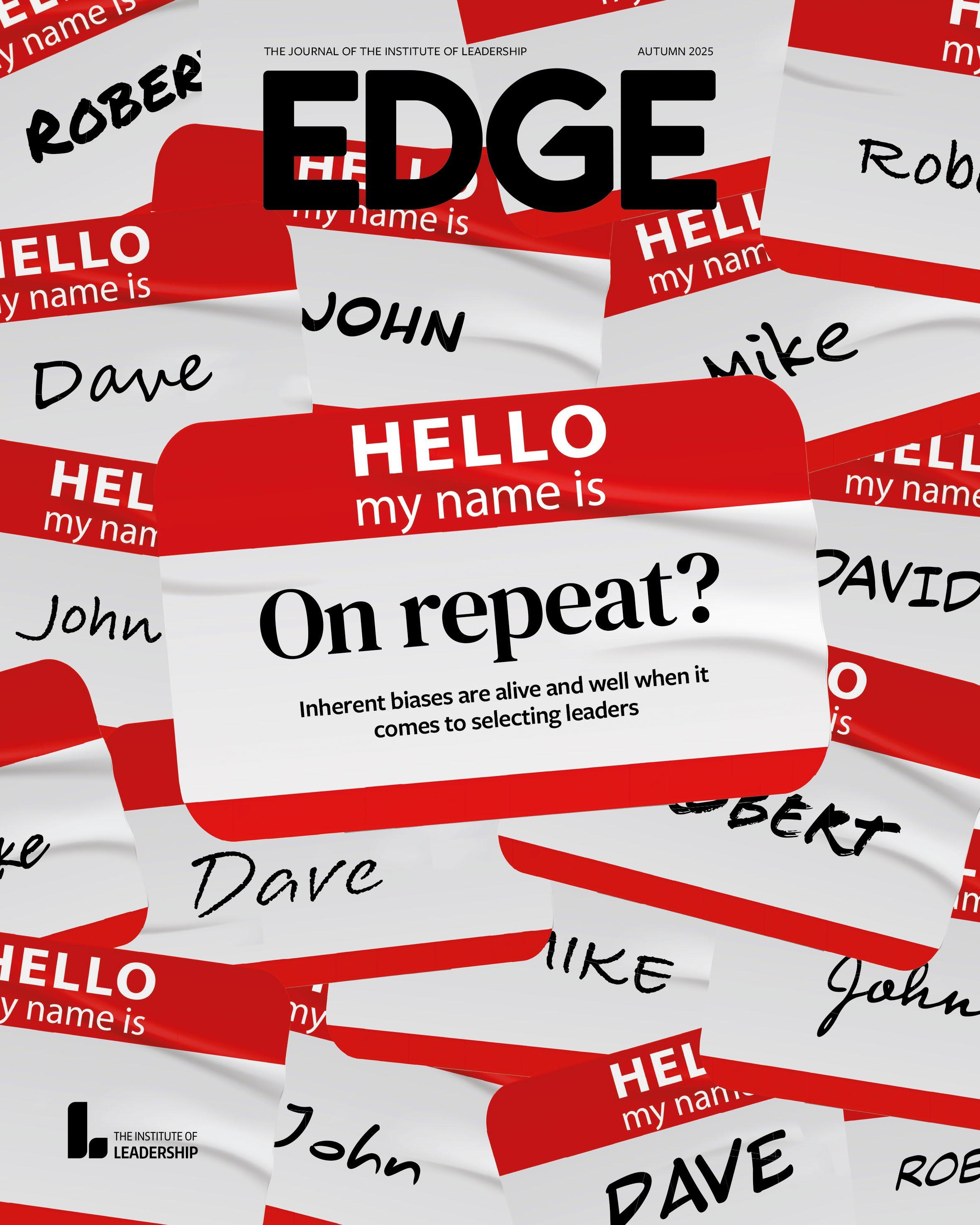
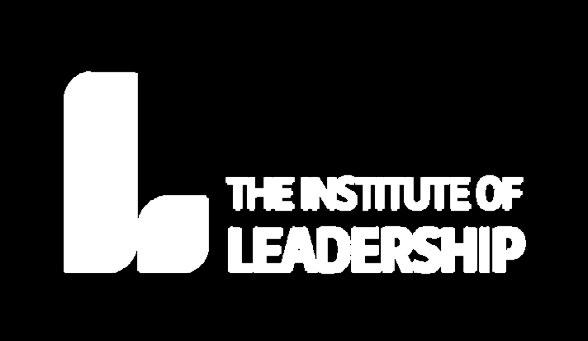





Celebrate the leaders making a difference.
Join us for the biggest night in leadership. An evening of inspiration, recognition, and celebration.
NOV 2025 14
Book your ticket now
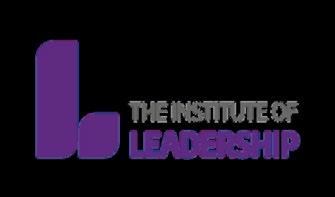
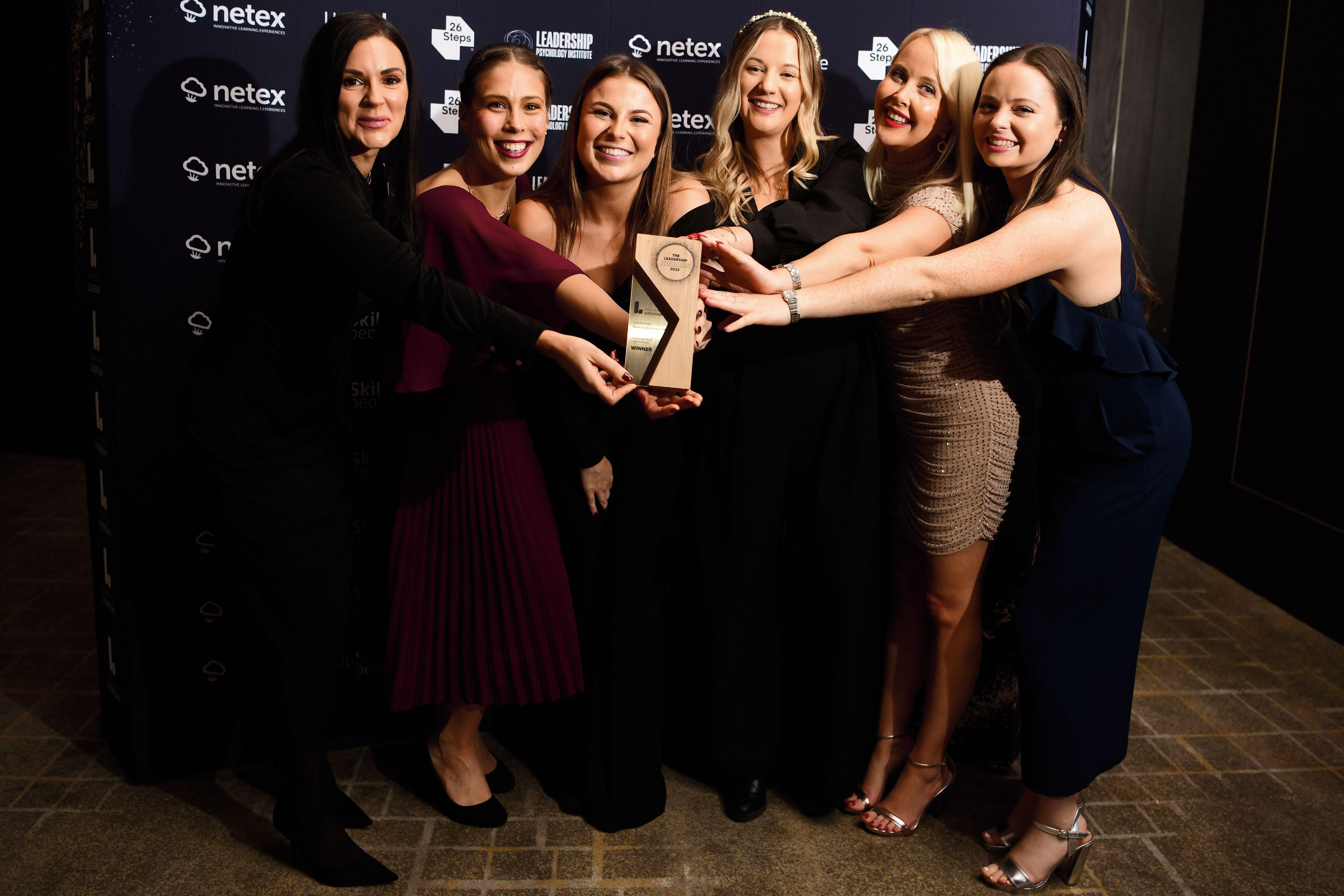



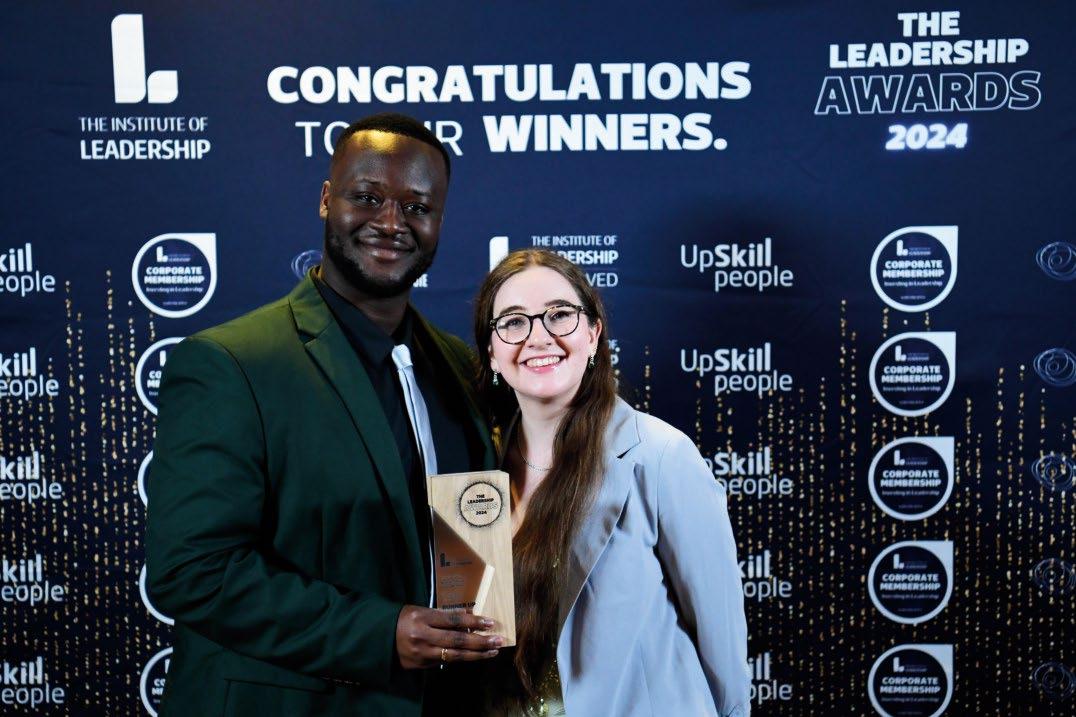






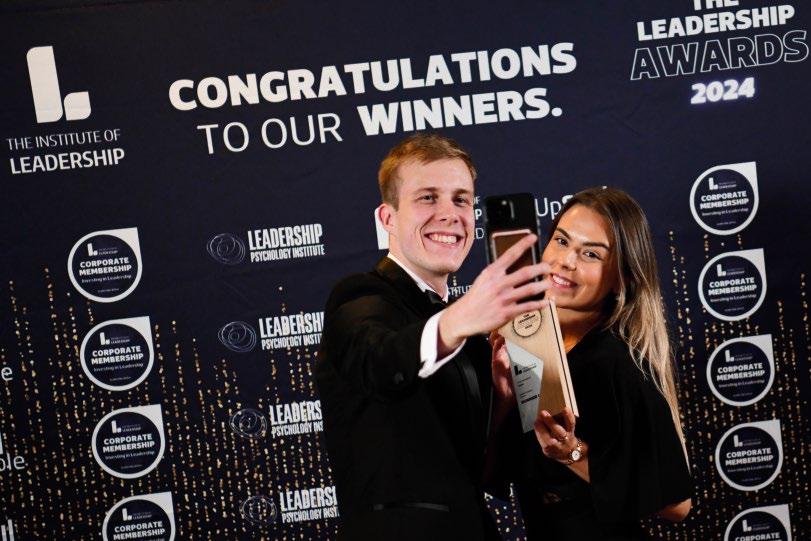
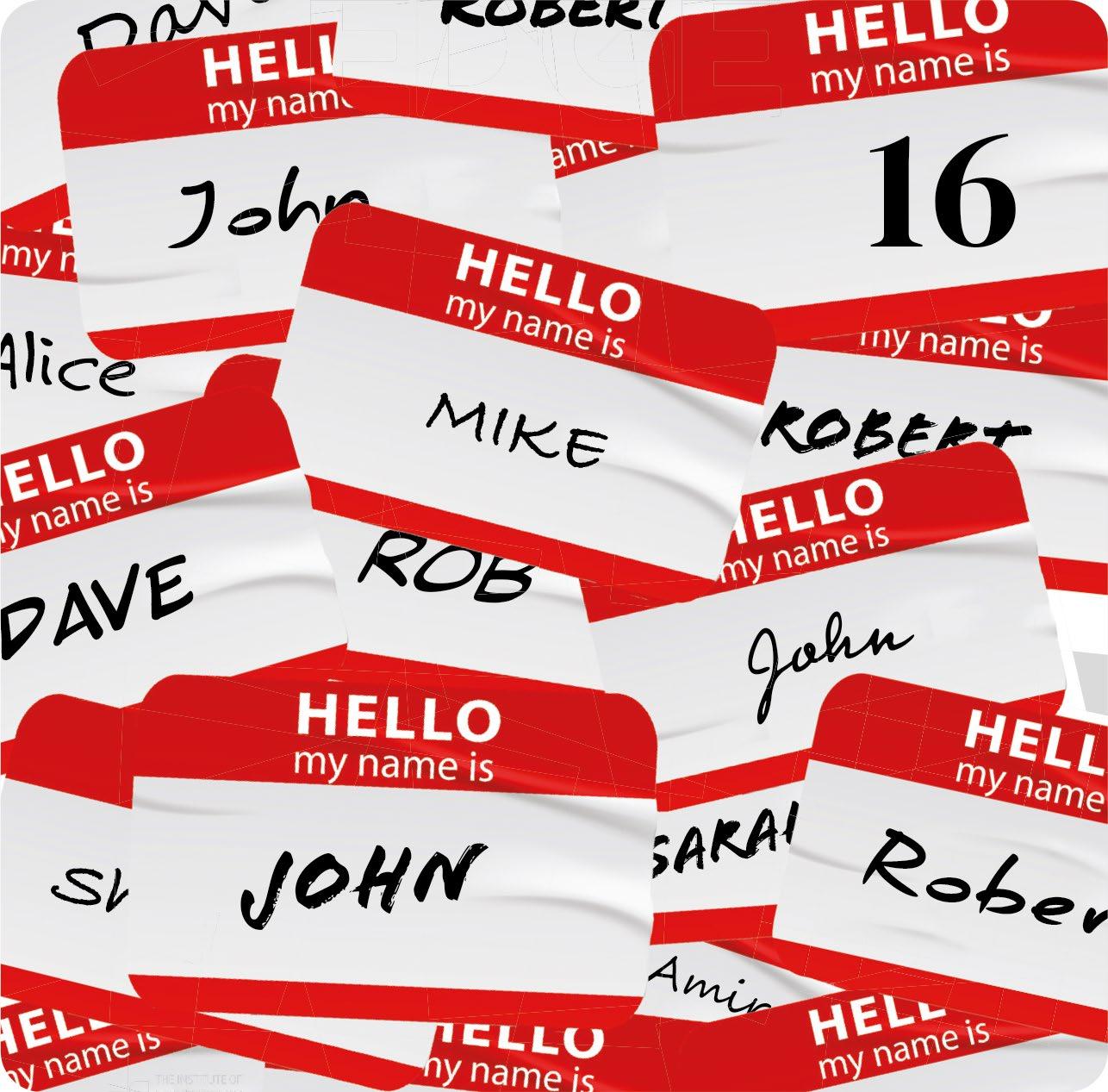





































































40 Why we need allyship
The urgent need for all leaders to build workplaces where everyone belongs and thrives


42 Are you prepared?
All you need to know about The Economic Crime and Corporate Transparency Act
49 The next level leader Preparing for the demands of leadership in 2030 and beyond
50 Bossing it
Aziza Anjum from Hounslow Council chats to her boss, Andrew Currie, about the need for new leaders, how a little bit of risk goes a long way and the importance of passing on the power
52 Keeping it real
Why authentic leadership will be needed more than ever in the AI era
54 Harnessing potential
The leadership skills you’ll need in order to manage the opportunities and risks of AI
62 When cancer knocks... What support do you have in place for your team?
64 A new lens Coaching for neurodivergent executives
66 Always on
Why you need to leave the emails behind – for everyone’s benefit
Focus on... payroll
57 Leadership in action Adrian Goddard from CIPP on the challenges the profession is facing
60 In numbers

This issue, we are looking at the inherent biases that exist when it comes to leadership and leadership opportunities. We cover many aspects, from gender and education to professional background and socio-economic status, but the research also uncovered some more surprising trends – such as that taller people are more likely to be leaders and you are more likely to be a CEO if you are named John or Mike! Our designer, Robyn, took the most popular CEO names to create an image using the concept of conference name tags to show this in a playful thought-provoking way. We also invite the IoL’s John Williams (6ft 8in) to share his route to leadership on page 9

By Louise Parfitt
We thought we knew what would be thrown up when we decided on this issue’s theme – the biases that exist in the leadership journey – but, as is often the case, the more you dig, the more you uncover. Our writer Peter Crush reveals some unexpected facts and stats about who is more likely to make it as a leader – and discusses whether this traditional career-pathing is an obstacle for organisational success in today’s changing world (see pages 16-21).
Meeting Emma Freivogel, founder of Radical Recruit, really broadened out my understanding of this topic (see our Edge interview, pages 32-38). The work undertaken by Emma and her small team – supporting people from marginalised communities back into employment – is both heartwrenching and heartwarming. Her story gives an insight into barriers that need to be broken
down, in society and in business, to ensure a more equitable future. If you are inspired by Radical’s work, give Emma a follow on LinkedIn.
I also had the privilege of meeting Aziza Ajum and her boss Andrew Currie, who feature in our ‘In conversation’ series on pages 50-51. I expect we’ll see Aziza in a leadership position very soon – read the article and you’ll see why!
We’re proud to include a report on the first IoL-commissioned research into the challenges facing the leadership community. We hope you find this interesting – it will inform Edge content and wider IoL initiatives in the future.
We are always grateful to our contributors from the IoL community and beyond who contribute their ideas and thoughts each issue. If you want more, head over to the new Edge online hub (ioledge.com). In the meantime, enjoy the upcoming IoL member celebrations (see pages 10-14).
If you have any feedback or a story to share, please get in touch. louise.parfitt@cplone.co.uk
Edge is brought to you by: CPL One cplone.co.uk
Editor Louise Parfitt louise.parfitt@cplone.co.uk
Art director Robyn McCurdy
Chief sub-editor Jo Halpin
Managing editor Helen King
Reporting team Martin Bewick, Tracey Lattimore, Ian Farrell
The Institute of Leadership c/o JW Hinks LLP, 19 Highfield Road, Edgbaston, Birmingham B15 3BH. ioledge.com
Chief executive John Williams
Director of events and engagement Rebecca Martin
Copywriter Ciara Conway
For advertising sales, please contact ciara.conway@leadership.global
Publishing Published in the United Kingdom by The Institute of Leadership.
Disclaimer Copyright 2025 The Institute of Leadership and CPL One. All rights reserved. Material may not be reproduced without permission of the publisher. While we take care to ensure that editorial is accurate, independent, objective and relevant for the readers, Edge accepts no liability for reader dissatisfaction arising from the content of this publication. The opinions expressed or advice given are the views of individual authors and do not necessarily represent the views of Edge, The Institute of Leadership or CPL One. Edge is printed on FSC-approved paper from responsible sources. Edge takes every effort to credit photographers but we cannot guarantee every published use of an image will have the contributor’s name. If you believe we have omitted a credit for your image, please email the editor.
ISSN 2515-7809
Printed by Paragon paragon.world





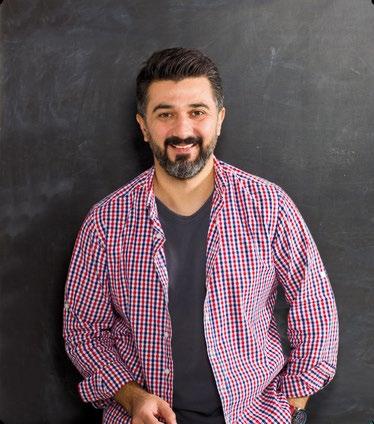

Discover if you’re ready for Fellowship
Take away application tips
Hear first-hand insights from an IoL Fellow




Reserve your place now



John Williams
Contrary to popular belief, there is more than one route to senior leadership. Note that I say ‘senior leadership’.
As human beings, we tend to reduce descriptors to the simplest denominator when we can. So, when we talk about senior leadership, we often use the term ‘CEO’ as the catch-all description. That has both advantage and disadvantage. The advantage is that it creates a descriptor that is immediately recognisable to anyone who sees it. The disadvantage is that it narrows the perception of what constitutes senior leadership – and the latter underpins the point of my piece today.
When considering the background and experiences that might characterise successful CEOs, it is vital to think outside the brand, not just outside the box. A CEO is only one position in an organisation, albeit one often seen as the culmination of a career trajectory. Leadership spans the whole organisation. Learning to be a leader is like learning to walk – initially, we need help to stay upright, and then we still need guidance on direction and pace. And, of course, that help and guidance does not, and need not, always come from above.
Increasingly, we understand that ‘the hero CEO’ is a myth. That has been reflected in the rise of quantum, servant, shared and situational leadership: a recognition that both the responsibility and the behaviours of leadership can, and do, reside at all levels in all parts of an organisation. Becoming a successful CEO demands the humility to allow for that –and to promote it.
My first CEO role was initially a catastrophe. No, seriously. When I took this to my mentor, plaintively wailing, ‘I can’t do this!’, and sobbing piteously, she just smiled quietly and told me that the first CEO role is always a mess at first. Every leadership role

we are given is an unprecedented learning curve. The old Zen philosophy has it that we cannot step into the same river twice. In the same way, every lesson we learn in our leadership journey, while necessary, is not sufficient to guide us in the next or subsequent roles. It is the steady amassing of these experiences, and the marshalling of them to build competence and confidence, that combine to make a successful CEO. When I went to work in the Middle East many years ago, nothing had prepared me for the blizzard of cultures and practices that characterise a multinational workforce. Yet no other experience could have opened my eyes so widely to the myriad ways in which the challenges can be met and turned into opportunities for success. Watching leaders with international experience was a revelation: seeing them move from behaviour to practice to instruction –whatever the situation; seeing them blend experience and innovation to power performance in their teams; and sometimes, seeing them get it wrong and the ways in which they responded to that challenge. That immersion in the panoply of good and bad leadership outcomes shapes much of my career.
Returning later to the UK, I found myself able to move between private, public
and third sectors, not knowing what to do – every leadership role is different and new – yet able to determine some of the routes to successful leadership by applying the experiences of the years. I discovered the importance of having a network, for generating and testing ideas, and for making those connections on which we all depend for success. I slowly began to understand the important difference between the meritocracy of the private sector and the politics of the public sector – and the way in which each emulates the other sometimes. I was astounded by the variety of work ethic I encountered around the world. In Hong Kong, the team that worked for me all had two jobs, and some seemed to have three! In the Arabian Gulf, I learned to relax and form relationships before imposing commercial discussions. I learned also, through a Japanese friend, that the onedimensionality of business can nevertheless be served by the serenity of Zen thinking.
All of this seemingly gratuitous blather is, in fact, relevant.
Becoming a successful CEO is a journey that never ends. There is no point at which we can say, ‘Whoa, that was tough – yet at least now I’m a successful CEO!’ Because it is not about us. It is about the impact we have on the people we lead. It is a truism to say ‘the role of a leader is to create other leaders’ – of course it is. Yet, it is deeper than that. The role of a leader is to create other leaders who can create other leaders. That can only be done with time, experience and a willingness to subordinate one’s egos. Look beyond the headlines, though.
A successful leader is one who leaves a legacy of successful leaders. Read that last sentence again. Now that, in my view, is what makes a successful CEO.
John Williams is chief executive of The Institute of Leadership.
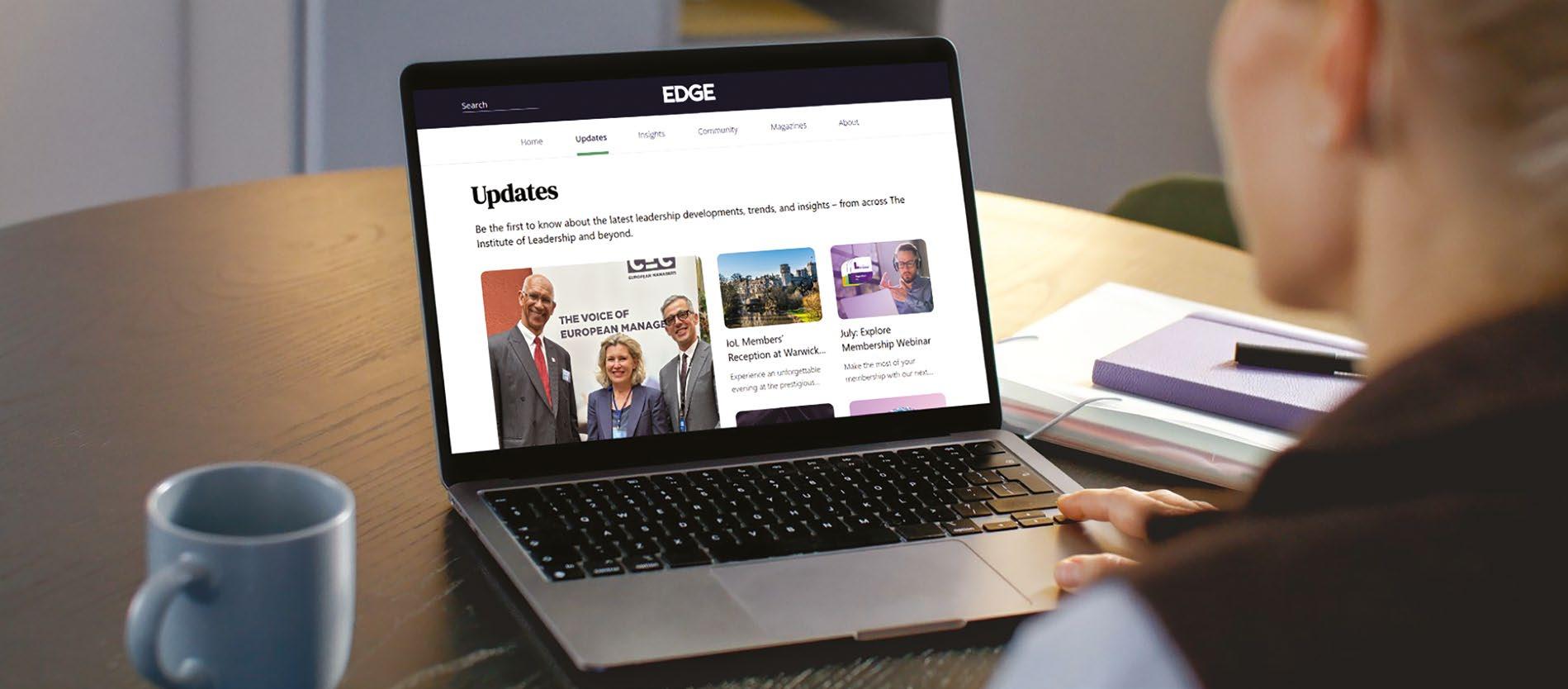
Edge Online , the new digital companion to your quarterly journal, has arrived! Now you can enjoy the same great content you love, along with exclusive updates, fresh insights and leadership news, all at your fingertips in between issues.
Think of it as your always-on leadership
hub: quick reads, expert commentary and announcements you won’t find anywhere else. And rest assured, the print edition isn’t going anywhere. You can still look forward to receiving Edge in print, direct to your door, or digitally through your member portal, with Edge Online there to keep you connected at other times.
Explore Edge Online at ioledge.com
We’re delighted to reveal the 10 recipients of this year’s Leadership Project Grant Fund, which backs innovative organisations with up to £5,000 to advance their leadership initiatives.
Congratulations to our 2025 Grant Fund recipients:
• Change In Youth CIC
• Click 2 Connect CIC
• Kimolian Community CIC
• Make Strides Learning and Development (supporting the Grace Kelly Childhood Cancer Trust)
• Run Wild
• Step Up Network CIC
• Team Papajasper CIC
• The Habbit Factory
• TiME – Technology in Music Education UK
• VIVA-GO
We can’t wait to see how these organisations bring their projects to life!
Grant Fund applications are now closed, but stay tuned for details of the 2026 round coming soon.
London Borough of Hounslow has partnered with The Institute of Leadership to embed values-led leadership across the organisation. With the belief that ‘leaders make the difference’, the council is developing a framework to help colleagues at every level grow their confidence and impact.
Early momentum is strong, with 25 colleagues enrolled across two Level 3 Leadership apprenticeship cohorts, growing engagement in values-based workshops and positive feedback in recent staff surveys.
Next steps include strengthening coaching skills among managers and building a clear leadership pipeline at team, operational and strategic levels.
Andrew Currie, head of organisational development and learning at Hounslow, said: “We believe leadership is a mindset, not a job title. We’re delighted to be working with the IoL, which shares this belief and provides the tools to help us continue developing our leadership culture.”
• Want to boost credibility for your leadership programme? Get Institute Approved Accreditation. Visit leadership.global/corporate/ institute-approved.html
• You can read more about the support Hounslow is giving to its emerging leaders on pages 50-51


Every year, thousands of people step out of military life and into a new chapter – a transition that brings opportunity and uncertainty. That’s why The Institute of Leadership is proud to partner with the Forces Employment Charity (FEC), helping service leavers, veterans, reservists and their families build the confidence and skills they need to thrive beyond the armed forces.
In 2024 alone, FEC supported more than 28,000 members of the armed forces community with advice, training and employment programmes across the UK.
Our new partnership builds on that impact: IoL’s MyCareers hub and mentoring platform will give veterans and their spouses access to practical tools, such as CV feedback and interview simulations, but also to something even bigger – an active community of leaders that understands the challenges of transition and wants to help.
This initiative highlights the often-overlooked role of military spouses, who play a vital part in every transition, and reinforces our shared commitment to the Armed Forces Covenant.
Rachel Mullings, membership manager at the IoL, said: “Leaving the military isn’t the end of leadership – it’s the beginning of a new kind. Together with FEC, we’re making sure no-one has to take that step alone.”
Eligible veterans and spouses can access support directly through their FEC employment advisers, while anyone preparing to leave the services can reach us at membership@leadership. global to explore the IoL’s wider resources.
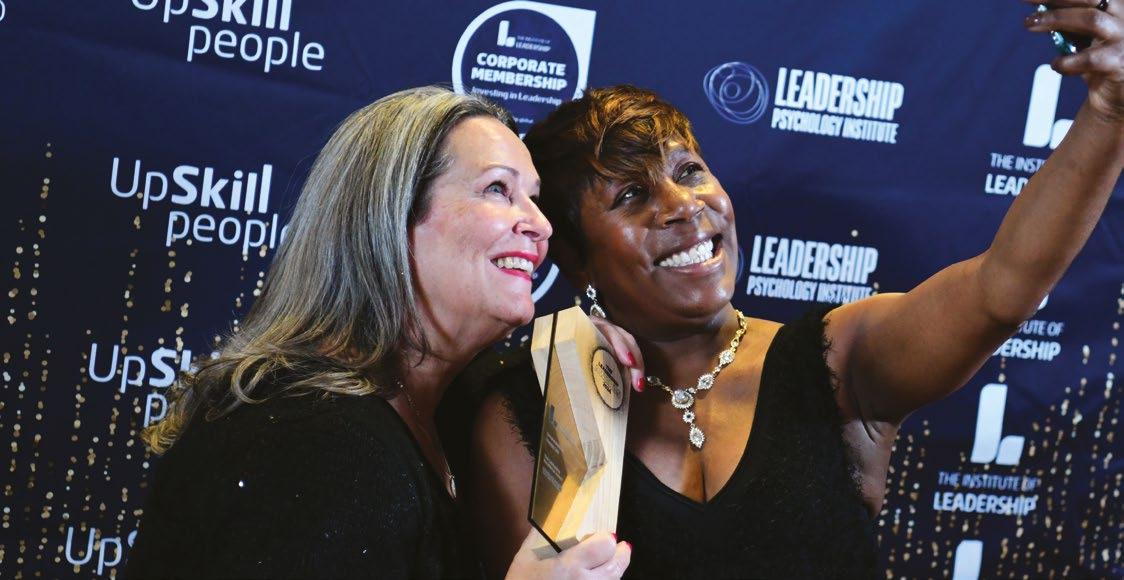
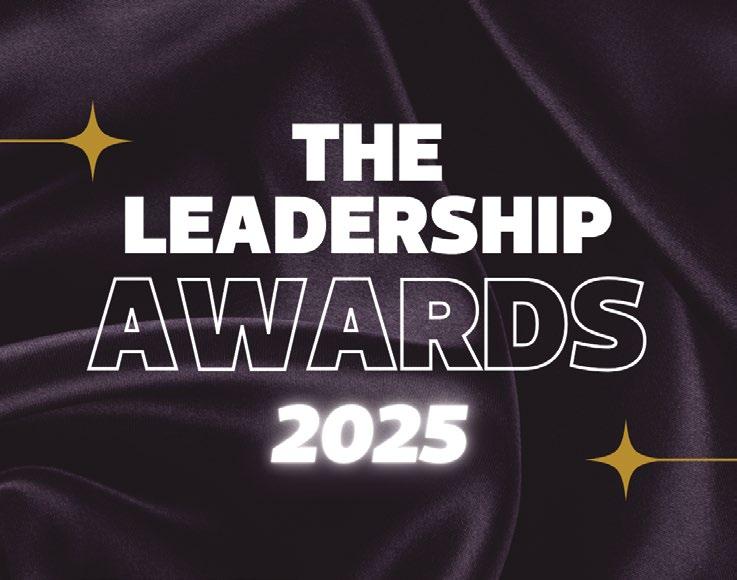
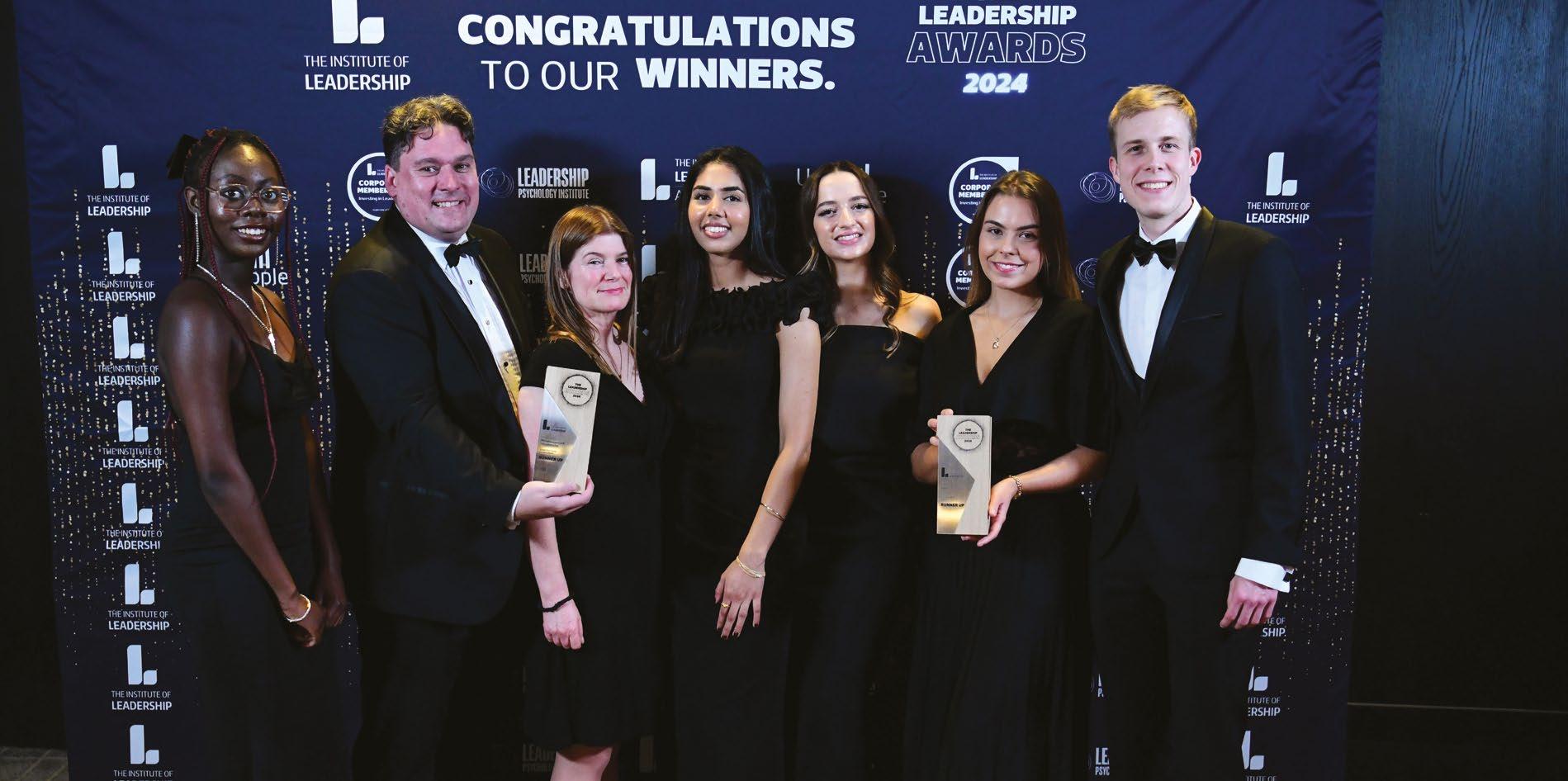
The IoL’s flagship Leadership Awards 2024 has been shortlisted for Best Celebratory Event by the Memcom Excellence Awards and the Association Excellence Awards (AEA).
It is shortlisted alongside five other standout events for the Memcom accolade, and alongside seven others for the AEA.
The IoL Leadership Awards shine a spotlight on emerging talent, exceptional leaders, innovative organisations, and initiatives that make a difference across our community, and in just a few
years have become the Institute’s flagship celebration.
The Memcom judging panel praised this year’s shortlisted events for their innovation in meeting evolving expectations while delivering truly memorable experiences. Being shortlisted once again confirms the Leadership Awards as a benchmark for professional celebration and community building.
The Memcom Awards take place on 25 September and the AEA on 7 November. We’ll let you know how we get on!
Get your tickets for the Leadership
2025!
Grab your tickets for the most anticipated leadership celebration of the year. The Leadership Awards 2025 black-tie event is the perfect way to round off the year in style, celebrating emerging talent, outstanding leaders and inspiring initiatives from across our community. This year, the event takes place on Friday 14 November, at Hilton London Bankside. Tickets are on sale now. Visit leadership.global to book.
A look at recent research on leadership and management from across the UK and internationally
For our autumn edition of Edge , we’re giving readers an exclusive first look at The Institute of Leadership’s inaugural research report, produced with Research By Design. Packed with insights from leaders across sectors, it highlights the challenges of today’s leadership landscape and offers expert insight on addressing them.
Enjoy the report, share your thoughts with us, and head to our Edge Online hub for deeper commentary and wider discussion on the findings.
Leadership takeaway: “From our research, we have been able to clearly draw out the major themes that are shaping the leadership agenda today – from economic and geopolitical factors, to the onward march of technology, to staff retention and wellbeing.” John Williams, IoL CEO
Top five challenges when managing teams
Recruiting the right people
Upskilling the workforce
Maintaining an engaged workforce
Providing a good work-life balance
Retaining employees and keeping top talent
Imposter syndrome isn’t just a personal challenge; it’s a business issue.
The Business Impact of Imposter Syndrome report from the Executive Development Network (EDN) reveals the true toll it takes on organisations, from lost productivity to higher staff turnover.
The numbers are striking:
• 53% of employees experience stress, anxiety or burnout linked to imposter syndrome every month
• It impacts 32% of people’s work performance
• Nearly half (45%) avoid promotions or opportunities as a result
• Employees lose the equivalent of 10 days a year over-preparing/striving for perfection
• 12% quit directly because of imposter syndrome, with it contributing to 26% of resignations overall.
The report also highlights that women and LGBTQ+ employees are disproportionately affected, and younger workers (18–24) miss the most opportunities.
Left unaddressed, this silent productivity drain chips away at people’s confidence and business performance.
Leadership takeaway: For leaders, this is a clear call to act. Tackling imposter syndrome means more than supporting individuals; it’s about protecting organisational capacity, retention and innovation. Investing in mentoring, coaching, inclusive leadership training and open conversations about self-doubt can transform hidden costs into opportunities for growth.
Read the full report, for deeper insights, at edn.training
Read more about imposter syndrome in the summer issue of Edge (pages 63-67).
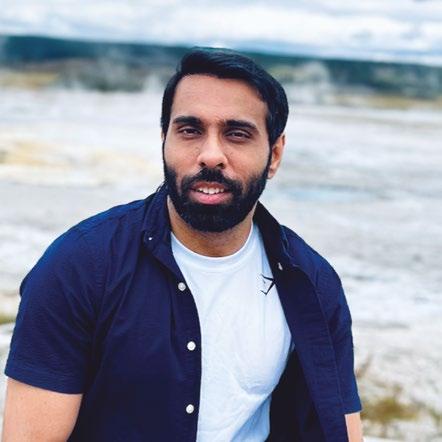



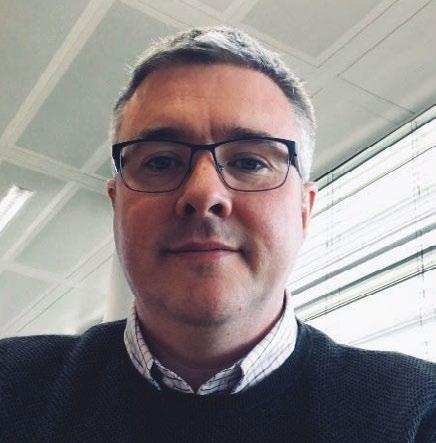

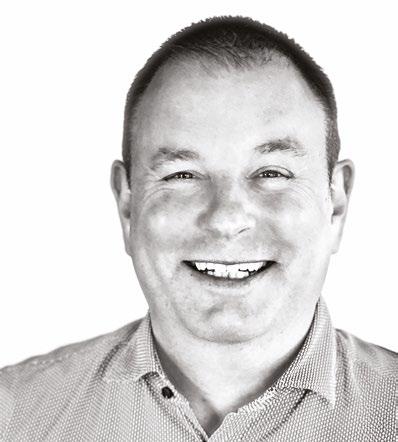

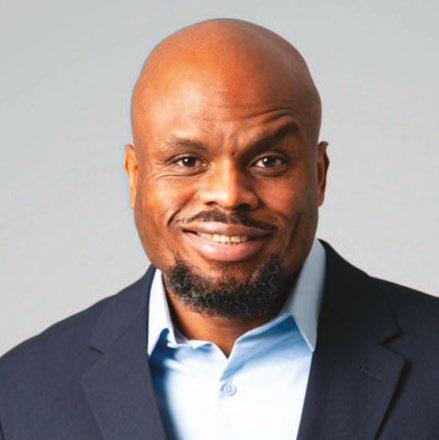
The Institute of Leadership is proud to welcome the latest leaders to join at our highest membership grade – Fellowship (FIoL). Fellowship is reserved for senior leaders with substantial experience and influence, who are committed to giving back to the leadership community. Congratulations to our newest Fellows:
• Sally East
• Neil Boyce
• Matt Sisto
• Anshul Gandhi
• Karen Heard-Laureote
• Daniel Whitcher
• Monei G Nthebolan
• Lionel Hachemin
• Muna Ibrahim Abdel Aziz
• Olusegun Otegbeye
• Rich Alvis.
Fellows gain internationally recognised post-nominals (FIoL), and also the
chance to mentor, share expertise and help shape the future of leadership.
Thinking about your own next step? Join our free webinar, Discover Membership: Your Path to IoL Fellowship, on 8 October 2025, when you’ll get insider tips and hear directly from current Fellows about the impact Fellowship has had on their journey. Register now at leadership.global/ whats-on/event-listing.html
Mel Robinson
When I think back to my very first idea of what a CEO looked like, the image is still vivid: big, intimidating men in dark suits, making decisions behind closed doors. They carried a kind of untouchable authority, and I couldn’t see myself in that picture at all.
Fast forward to today, and I am stepping into the role of interim managing director at ABE, a global qualifications provider with reach across multiple continents. Since 2024, ABE has been part of The Institute of Leadership, a partnership that brings together world-class expertise in leadership development and global education. For me, that connection is powerful – it means combining ABE’s international reach with the Institute’s mission to inspire great leadership everywhere.
I’m young, female, and don’t fit the stereotypical mould – which is precisely why I think this moment matters.
The data in this issue’s lead feature makes for sobering reading. Only 11 of the FTSE 100 CEOs are women. More than half of the world’s CEOs are taller than six feet. Many are drawn from the same professional and educational backgrounds: private schools, elite universities, banking and finance. By that measure, I tick one or two boxes, but miss most of the rest –and I’m glad of it.
My career began in finance because I loved numbers. I was happiest in front of a spreadsheet, not imagining myself managing people, let alone leading organisations. Leadership wasn’t part of my plan and, if I’m honest, I didn’t see people who looked like me doing it. I even took time out of my career at 30 to snowboard and sail for 18 months, and couldn’t have imagined returning to a boardroom at that point.
Gradually, however, I found myself responsible for more teams, more departments, and more decisions. What I discovered was

that leadership wasn’t about fitting a mould; it was about understanding people – their motivations, ambitions and anxieties. I realised the impact I could have, not just on results, but also on how people felt about their work and careers. That changed everything.
I used to believe you had to be strict to be a leader, that authority demanded distance. Now I know respect is earned through empathy, collaboration and authenticity. My leadership style is softer than I ever imagined it would be – and that’s a strength, not a weakness.
This next step at ABE excites me because it’s global. It will stretch me, expose me to new markets, and challenge me to bring people together across cultures and contexts. Being part of the IoL strengthens that further: together, we can demonstrate that leadership doesn’t have to follow a stereotype – it can be inclusive, authentic and truly global.
“Titles, qualifications and background matter less than the ability to connect and to inspire”
My job isn’t to be the loudest voice in the room; it’s to build trust, to take the team with me, and to create an environment in which everyone feels they have a stake in the organisation’s success. Maybe that’s the bigger point: the ladder doesn’t make you a leader. Titles, qualifications and backgrounds matter less than the ability to connect and to inspire.
If my appointment challenges even one young professional to rethink what leadership looks like, it will be worth it. You don’t need to look like the stereotype and you don’t need to lead like the stereotype. Leadership isn’t about becoming someone else. It’s about becoming more of who you are. Finance may have been my foundation, but it hasn’t defined me.
I look forward to sharing the global perspectives we’re uncovering at ABE and the IoL over the coming weeks and months.
Mel Robinson is interim managing director of ABE.
Experts
argue professional background biases are alive and well when it comes to selecting leaders –but this has to change
Peter Crush Writing
Olivia McMillan believes she would never have achieved her recent leadership roles without a boss who was more interested in where she could get to rather than where she had come from.
“I was doing OK in a company in Australia, but I wasn’t exactly excelling,” she recalls.
“I was in product management, but it wasn’t my passion – leadership was. While this wasn’t my background, I could see we had teams that were disconnected. I mentioned this to my senior manager, who then passed it to the CEO. Not long afterwards, the CEO phoned me and said, ‘What if I said you could take on one of these teams yourself?’ Of course, I jumped at it.”
This single ‘sliding doors’ moment started a career journey that saw McMillan appointed head of service delivery at Zoopla.co.uk before ascending to her current role, COO of cloud accounting software company iplicit.
And now she’s the one in a position of influence, she’s promised never to assume leaders have to ride a certain track. “I wasn’t ‘traditional’ leadership material in the sense that this was already the path I’d started to tread,” she says. “But my boss saw my transferable skills, and had faith to put me into management/ leadership. I’ve never forgotten this. I now make sure a nine-box grid model [a talent management framework to evaluate employee performance and potential] is applied to all
potential leadership talent, just to make sure the leaders of the future are not overlooked.”
What a shame there aren’t more leaders like McMillan. “The way we recognise leadership potential, including deciding who gets the opportunity to develop it, is broken,” says Rohan Whitehead, coordinator at the Institute of Analytics. “Talent is not in short supply, but when we talk about leadership selection and potential, organisations still revert to familiar reference points: top-tier degrees, consulting experience, or strategic roles in finance. These backgrounds are linked to confidence and polish, but they are far from being the only places where modern leadership skills can develop.”
He adds: “We know that private schools and elite universities are still over-represented in leadership [globally 13% of the top CEOs attended Oxford or Cambridge University¹], but while certain degrees still carry incredible weight, when it comes to the quality of education, they can no longer be relied upon as an indicator of leadership potential.”
background
Such is the apparent predictability of leadership pools that experts often talk about there being a strong professional background bias to leadership, where once someone’s foot is in the door, the rest of their ascendency is secured – often because existing leaders gravitate to
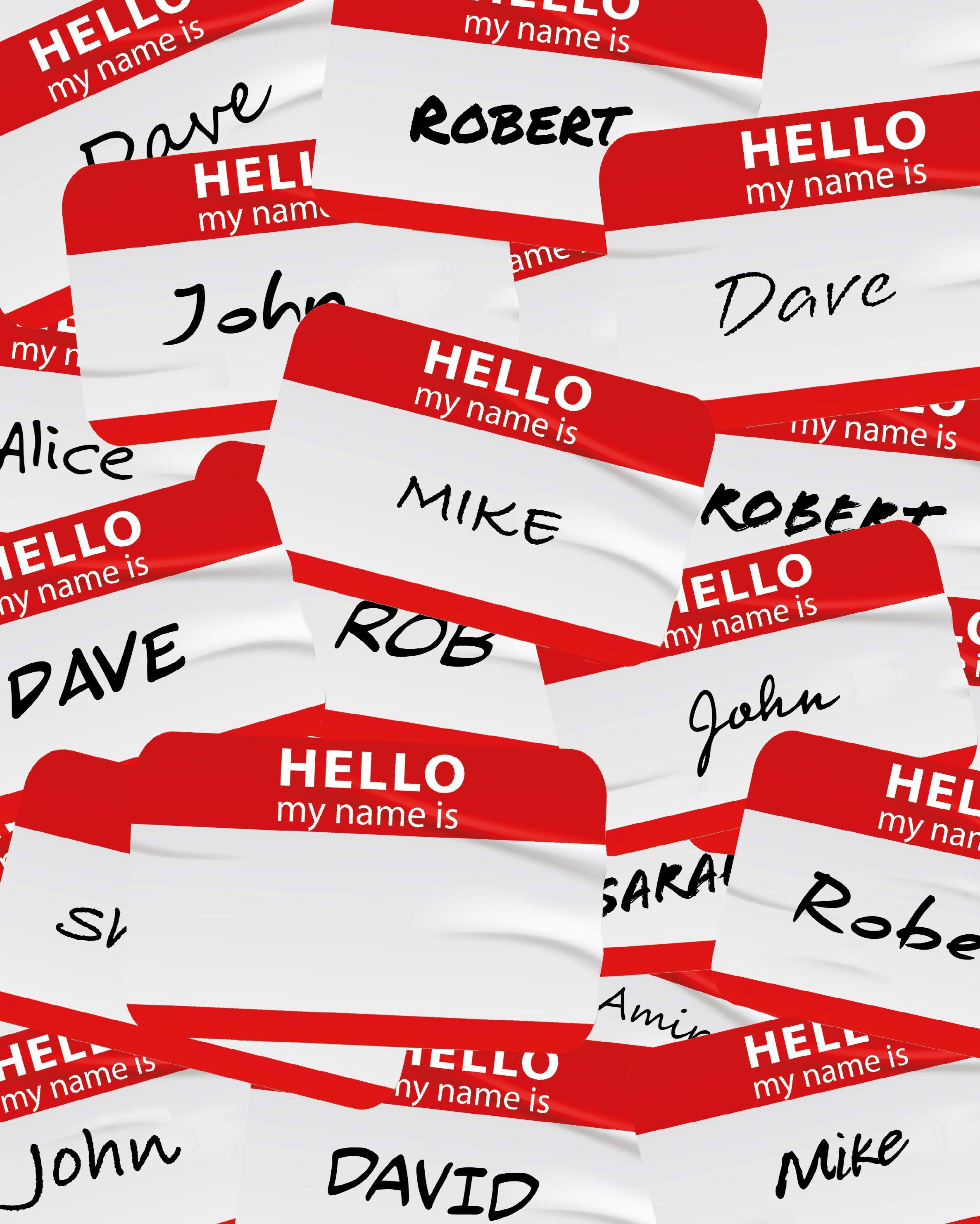
“The way we recognise leadership potential, including deciding who gets the opportunity to develop it, is broken”

“It’s not just about hitting diversity targets but ensuring that people from different backgrounds have real access to the experiences and mentorship needed to succeed at the top”
those with similar professional backgrounds.
This theory certainly has merit. Data shows almost half of the world’s CEOs hail from a finance and banking background.²
“There is definitely a persistent professional background bias when it comes to leadership,” observes executive coach, Liz Sebag-Montefiore. “Certain roles – such as strategy, finance, or consulting – are seen as leadership pipelines while others, such as HR or frontline roles, are overlooked, even when individuals have demonstrated strong leadership qualities.”
Adds Simon Fabb, CEO at ChiefJobs.com: “We know that leadership pathways often follow traditional routes that favour certain professional backgrounds, and – as such – are more likely to exclude talented individuals from under-represented groups.”
Dave, Mike, John and Rob
So strong are these forces still – not least when it comes to gender diversity – that for a long time there’s been an infamous business statistic: someone is much more likely to become a CEO if their name is David or Michael than anything else. In 2023, 34 Davids headed one of the world’s top 1,000 largest companies, followed by 32 Michaels (with Johns and Roberts featuring fairly highly too – each had 24 of the top 1,000 companies in 2023).³ And in 2024, only 11 FTSE 100 companies were run by women.⁴
Other studies have even revealed everything from stature to attractiveness are forces behind leadership selection.⁵ Some 58% of CEOs are above six feet tall (compared with 15% of the general population), while a Journal of Economics and Business study in 2023 showed how ‘more attractive people’ earned 24% more than their ‘less attractive’ colleagues, and rose to higher positions accordingly.⁶
While these studies might well be seen as frivolous, some critics say they also reveal a harsh truth – that disproportionate levels of UK
leaders are white and privately educated. Half of FTSE 100 senior executives were found to have been privately educated, compared with just 7% of the UK population.⁷ It’s a statistic that suggests very strong forces impact executives’ future career paths.
Tsvetelina Nasteva, an HR expert who is manager of human resources and talent acquisition at Casinoreviews.net, is scathing in her assessment of what these biases produce.
“Same schools, same roles, same ladder,” she says. “It feels safe, but it also means we keep recycling the same type of leadership. From my perspective – in HR – this creates a narrow pipeline and closes the door on people who bring a different kind of value, especially those who didn’t start from the same places.”

One striking example of a woman who has – literally – fashioned her own route into leadership is Alexandra Wood, Savile Row’s first female tailor and shop owner on this traditional male-dominated street.
Whatever data set one looks at, many of the same conclusions can be reached – if you are a privately educated, heterosexual white man, you are more likely to be a leader – particularly if you are tall, do not have a disability and come from the financial sector.⁸
So, what can/needs to be done? “Something definitely needs to change about the C-suite developmental journey,” says Georgina Badine, founder of Invicta Vita, which supports professionals, particularly women, who are facing uncertainty in their careers. Having herself battled to work her way up in the male-dominated financial services sector, she says she’s faced bullying, harassment and a culture where leadership success has often been defined by dominance.
A diversity, equity and inclusion (DEI) approach is certainly one that’s needed on some level, she says, because good prospects are not otherwise visible.
“Those in finance – typically white men from a good university – are assumed to be leaders because of their background and what they’ve already done,” she says. “But this traditional route needs to be seen as outdated. Today, the ability of leaders to ‘connect’ matters more than what school they went to. The problem for wannabe leaders of the future is that expected pathways can still work against them. Around 50% of leaders are currently inpost who shouldn’t be there. They’re just there because they’ve climbed the expected rungs. But climbing the ladder doesn’t make them good leaders. They get promoted because they shout the loudest, while those with quiet selfbelief don’t get on people’s radars.”
Her ‘break’ happened after a CV she left at a tailor’s was (remarkably) found two years later under a pile of paper. The first day she was supposed to start as an apprentice, the firm’s tailoring manager left, and she was trusted with the chance to take that person’s job.
“I suppose I had brazen confidence at the time,” she recalls. “But I proved myself, and that’s the thing. I was passionate and, fortunately, I was then able to be my own best salesperson. But I see clients today – people in the city – who say they’re on this expected treadmill, when really they know there are better people around them that could be given a chance.”
So what should organisations do to avoid the trap of ‘expected career-pathing’? In an already uncertain business landscape, can they really afford to take a punt on otherwise good, but unproven, people?
There is, it seems, real potential for return on investment for companies who promote their own employees into first-time management roles – and that’s because sought-after leadership skills can be easily taught.
That’s the finding of research by Anne Trumbore, chief digital learning officer at the Sands Institute for Lifelong Learning at The Darden School, University of Virginia.
“We know that the lack of a degree can act as a barrier to leadership roles, and that many companies use degrees, or sometimes the school people came from, as a proxy for leadership potential,” she says. “But actually, there are collections of leadership skills that can be taught on the job, which enable workers from varied backgrounds to take on leadership roles, as long as the company
Of CEOs in the 97 FTSE companies analysed by the 2024 Raconteur CEO Index, only:
13 were not white European background
11 were women
1 had publicly come out as LGBT+
0
had declared a disability
“Once someone’s foot is in the door, the rest of their ascendency is secured –often because existing leaders gravitate to those with similar professional backgrounds”
invests in providing training in these important skills. Many partners we’ve worked with have found ways to tap this unseen talent to drive ROI for their organisations – simply by applying these coaching principles.”
Fabb believes overlooking non-traditional talent pools can harm an organisation: “If DEI isn’t embedded in how future leaders are identified and developed, organisations risk missing out on diverse perspectives that drive innovation and better decision-making,” he says. “It’s not just about hitting diversity targets but ensuring that people from different backgrounds have real access to the experiences and mentorship needed to succeed at the top. This means remodelling recruitment, promotions, and leadership development programmes to be more inclusive by design.”
At iplicit, McMillan says she formerly organises ‘coffee roulette’ sessions where two people in the business (people who may never normally get the chance to interact with each other because of the jobs they do) can get to know each other. It’s done precisely, she says, so she can be more intentional about finding future leaders from unexpected places. “Paths are non-traditional now,” she says, “so I have to find ways of tapping into the strength of people who may be in a role for one of many reasons.”
Sebag-Montefiore agrees that “the C-suite needs a reset, moving away from linear, traditional paths and embracing more inclusive, skills-based progression. This isn’t just for fairness, but because the complexity of today’s world demands a wider range of lived experience and thinking when it comes to leadership.”
It’s a view that’s widely supported by others. Rebekah Allen is an expert in sustainable fashion and the founder and CEO of jewellery brand Le-Serey. “We know that employees from lower socio-economic backgrounds still take about 15% longer to reach senior leadership, even when their performance matches their peers’,” she says. “Around one-third of the best-performing global chief executives hold

of FTSE 100 CEOs are educated privately, compared with 7% of the UK population
engineering degrees because firms value the structured problem-solving that seems to come with that training.”
But the result, she says, “is that they often overlook candidates from sectors who solve production problems every day. After a decade working with rescue teams across India, I learned to test potential without relying on titles. We advanced local leaders by rotating them through legal outreach, survivor care, and logistics. This method surfaced people who could adapt, listen, and decide fast; qualities any enterprise needs. When I moved into sustainable jewellery, I kept the same habit, pairing bench artisans with brand strategy projects so their on-the-ground insight feeds commercial planning. It costs little and keeps the leadership bench wide.”
Making the change
The problem is that doing things differently is not easy.
“Until there is ‘real change’ – that is where companies actively challenge biases and create environments where leadership potential is

“DEI is often talked about, but real change means looking at who we’re mentoring and why. Companies need to stop treating leadership potential like it only comes from a certain pedigree”
recognised in a wider range of people, regardless of socio-economic status or appearance –leadership pipelines will favour those who fit an established mould,” says Emily van Eyssen, founder, Remote Recruitment. “Leaders should question their own assumptions about who makes a good leader.”
Gizem Sultan Kartalcik, HR specialist at Tor.app, agrees. “I’ve seen talented people from less ‘traditional’ backgrounds passed over because they didn’t fit the mould,” she says.
“Meanwhile, others with less experience get promoted because they check familiar boxes.
“DEI is often talked about, but real change means looking at who we’re mentoring and why,” she adds. “Companies need to stop treating leadership potential like it only comes from a certain pedigree. Diverse perspectives don’t just check a box, they change how teams solve problems, grow, and lead.”
But perhaps, these messages are now gradually starting to get through. “My own journey, from civil engineer to chief executive, has taught me that early career choices can open doors – but do not lock them,” says Jeff Kaiden, CEO at business advisory firm Capacity. “A technical degree sharpened my problem solving, but coaching youth football did even more for my communication skills. Leadership often grows out of side experiences that teach patience, delegation and quick adjustment when a plan stalls. When I fill management seats at Capacity, I look for people who have stepped outside their formal role to guide others through challenges, because those moments reveal real leadership habits.”
If more leaders are like him, or McMillan, or Badine, then perhaps old-fashioned routes to leadership can be successfully challenged.
of FTSE 100 CEOs have a qualification in business, economics or finance
“If leadership wants to change, it has to start by seriously expanding what ‘qualified’ means, and that means bringing in fresh perspectives from all walks of life,” believes Vicky Owens, founder and CEO of Socially Speaking Media. “I’ve seen leadership bias close up as a Gen Z founder who has built a social media agency without the usual corporate background. Plenty of people with proven results get overlooked because they don’t fit that ‘traditional’ mould.
“Experience isn’t about job titles or fancy degrees,” she adds. “The idea that good leaders only come from finance, consulting, or big legacy firms is outdated and misses the point entirely.”
Peter Crush is an award-winning HR-specialist journalist, writing about all aspects of leadership and the world of work.
1 Novuna: see bit.ly/EA25RA
2 Robert Half: see bit.ly/EA25RB
3 Allsorter: see bit.ly/EA25RC
4 Raconteur: see bit.ly/EA25RD
5 Financial Times: see bit.ly/EA25RE
6 Journal of Economics and Business: see bit.ly/EA25RF
7 Raconteur: see bit.ly/EA25RD
Charlotte Otter
With the pool of UK CEOs still largely male and anaemic – combined with companies quietly deprioritising their diversity, equity and inclusion (DEI) programmes – the ability to redefine the modern CEO seems like a challenge that’s currently insurmountable.
But the face of leadership can’t stay the same when the world around us is changing. We have the twin vectors of change – five generations in the workplace and the pressures of AI – present in almost all companies. And picking white male CEOs with a finance background to lead a highly diverse workforce and consumer base won’t be a sure-fire survival tactic forever.
DEI isn’t a ‘nice to have’, or even an ethical stance; it’s a demographic reality for modern, complex organisations serving modern, complex markets. Jess Von Bank, an HR analyst at Mercer, said in a recent LinkedIn post that transformation is always more about cultural and organisational readiness than technology readiness. So, how do we get ready for new leaders? On the organisational side, we need to see more inclusive recruitment, hiring, remuneration, rewards and promotions. Who organisations hire, reward and promote –and for what – is very telling.
Leaders who aim to become more inclusive need to learn and model behaviours in their teams. They need to
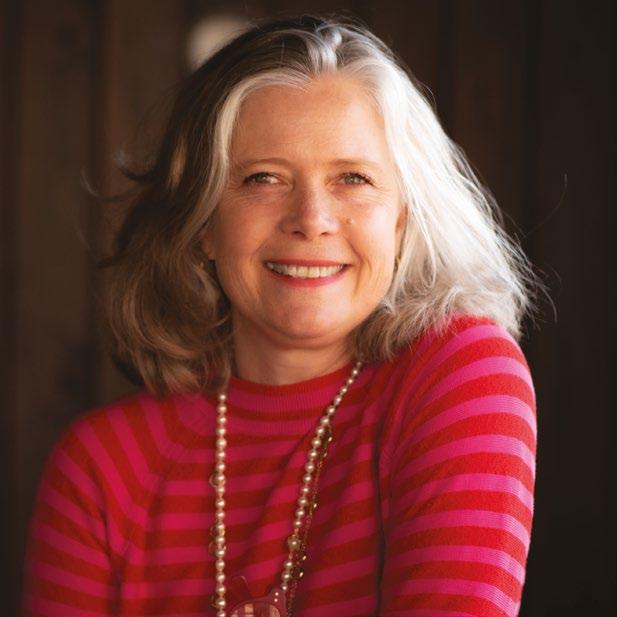
“Picking white male CEOs from a finance background to lead a highly diverse workforce and consumer base won’t be a sure-fire survival tactic forever”
be equity minded, run inclusive meetings, ask for feedback and be prepared to have difficult conversations. Someone I interviewed for my book explained that if someone in her work orbit says something offensive or that feels like micro-aggression, she doesn’t shame them publicly. Instead, she takes them aside for a quiet conversation, tries to understand what they meant and to
explain how that might land with the individual in question. Change happens in quiet one-to-one conversations.
Leaders from diverse backgrounds, identities or under-represented minorities with an ambition to reach the C-suite need to learn to talk about their success. Doing a great job is only half the work; the rest is talking about it. This is not about obnoxious self-promotion but about building a reputation for consistently doing excellent work that supports business strategy. In her excellent book The Authority Gap, Mary Ann Sieghart says that a superb record of success can act as a ‘buffer against bias’.Leaders building their reputations can lean on their company’s communications team to find external media and speaking engagements, but they can also use the social media platforms available to showcase their success and, even more importantly, their personality and opinions.
Building reputation equity is a power tool for leaders from diverse backgrounds. Not only does it show those following what is possible, but it builds a bridge to leadership for those who’ve only imagined it as a possibility. Reputation equity is an engineering feat that helps others cross the bridge towards the C-Suite.
Charlotte Otter is an executive communications expert, speaker, adviser and author of We need new leaders: Mastering reputation management to reshape the C-Suite.
Rich Howell
There’s a new wave of bias when it comes to those candidates companies wish to interview
When you work in recruitment, you hear all sorts of strange ideas – some bizarre, some downright ridiculous – from companies about what candidates need to demonstrate to even get to interview stage. However, in the past few weeks, I have heard something that has left me shocked to the core.
Four candidates have approached me asking the following question: “Is it normal for recruiters to refuse to work with me because I am currently out of work?”
I thought the first person was joking, but then a second said the same, then a third came forward and then I heard it for a fourth time... And no, this attitude is not coming from the same firm, but from four different companies.
Even more shockingly, one candidate said they were told by a company that “employed candidates were of better ‘quality’”.
I was absolutely speechless when I heard this. I am embarrassed for the whole of the recruitment industry. The impact this will have on candidates I work with – from entry-level up to experienced leaders – is huge, but it has no grounding in facts.
Calling it out
Where has this bias come from? I have no answer to that question.
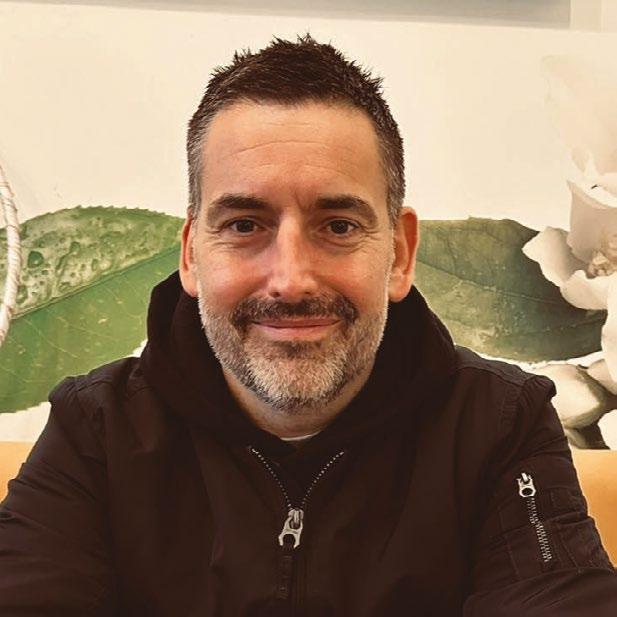
“In the past few weeks…. four candidates have approached me asking the following question: ‘Is it normal for recruiters to refuse to work with me because I am currently out of work?’”
I can only take a wild guess that there is an incorrect assumption that someone already in work might be more able to hit the ground running and earn the company a few quid quicker – and if so, it is just the pits. It overlooks everything else about the candidate – their skills, qualifications, experience and suitability to the role.
For me, I would sooner give a job to someone who is unemployed over being employed at the moment. That’s how strongly I feel about this subject and helping those out of work.
At some point we need to start calling out these companies and the people making these insane decisions. Otherwise, this attitude will continue – and there is absolutely no reason for it.
We are in a real crisis situation in this country at the moment and people need a break. Companies that do this are seriously contributing to a huge problem and a wave of mental health issues.
There should be no inherent bias in vetting people for a role based on their current work status. End of.
Rich Howell is co-founder of Marvel FMCG Recruitment.
Would you like to take part in our next debate? Please email louise.parfitt@ cplone.co.uk to find out more.

Are we forcing leaders to be inauthentic, asks Nik Kinley
As a buzzword, authenticity has been admirably successful. Google Scholar returns more than five million academic articles on the subject and Amazon more than a thousand book titles. Yet, for all the hype, the idea is frustratingly vague. Ask 10 people what it means and you’ll get 10 different answers. The general gist, though, is that an authentic leader is selfaware, true to themselves and honest. The idea is that this is good for business because it fosters trust and motivation, which, in turn, boosts performance.
Whether authenticity is genuinely valuable or just another leadership fad is debatable, but the fact that it’s become a thing at all says something telling about the state of modern organisations.
Authentic leadership gained prominence in the early 2000s, but its roots lie much further back in time. Ancient Greek philosophers extolled the benefits of living according to one’s nature, while more recent existential philosophers talked of the need to be authentic to your beliefs in a world that pushes people to conform. Then, in the 1970s, as organisations grew increasingly complex and bureaucratic, some commentators began to describe management as dehumanising and called for a more personal, less mechanistic approach to leadership.
The common thread to all these was the idea of ‘being yourself’, and it’s the reason authenticity has caught people’s imagination and become so popular. It speaks to a very real and basic tension that exists at the heart of most work: the fact that you can’t just be yourself in the workplace. At least not entirely, because being professional involves some degree of self-restraint and, therefore, some element of inauthenticity.
This is especially so for leaders, because they have extra responsibilities. Not just in terms of having to tell people what to do and sometimes having to tell them to do things better, but also in terms of helping to motivate people, keeping others positive and shielding teams from stress. That means, if you’re a manager and you’re having a bad day, you have a responsibility to not be wholly authentic, to at least partly shield your people from your stress. So, the very nature of your role as a leader requires you to often be inauthentic and it is this tension that the authenticity movement has tapped into so successfully.
To be clear, this basic authenticity tension isn’t organisations’ fault – it’s just a natural part of being a leader. But that doesn’t mean firms are blameless, because there is a growing trend for them to accidentally make the situation much worse.
Over the past five years, a new trend has emerged in academic research – the study of corporate BS; how organisations will spin a story that tries to cover bad news as good news to their employees. Here’s a real-
life example: a firm beginning a restructuring process that will result in job losses positions it to employees in an upbeat, positive manner and talks about it as an opportunity – a communication that many of the employees experience as inauthentic, and that managers and leaders are stuck having to defend.
It is far from an isolated example. As a rapidly growing trend within organisations, it is an extension of a much broader global societal trend for people to focus on impression management. You see it in social media, and how people invest in personal branding and hunting for likes; you see it in political leaders, in how they seek to control the narrative and manage their image; and you see it in organisations, in how they try to manage their brand internally and externally, controlling the messaging to employees just as much as to customers.
This is the source of what academics call corporate BS, and what is creating an all-new and entirely artificial source of inauthenticity for leaders. The fact that they are having to repeatedly defend inauthentic and sometimes plainly false corporate communications, and to bridge the gap between the narratives that organisations want their employees to believe and the realities that employees actually experience.
“The very nature of your role as a leader requires you to often be inauthentic and it is this tension that the authenticity movement has tapped into so successfully”
For the past 100 years, commentators have lamented the mechanistic nature of leadership, complaining that it forces leaders to be something they aren’t – but, in many respects, this criticism has been unfair. It has not so much been organisations forcing leaders to be inauthentic, as leaders themselves feeling a responsibility to behave in a certain way and shield their people to a certain degree. So organisations’ culpability has been debatable. Not any more, though.
The growing focus on internal communications and branding, while creating new fields of interest for academics, is building a fresh and very real crisis in authenticity for leaders, increasingly placing them in impossible positions. And this is a crisis that can’t be solved by sending leaders on an authenticity course. It isn’t one that can be worked around with slicker messaging or a cleverer piece of internal branding. There’s only one solution, and it’s not that leaders need to be more authentic – it’s that organisations do.
Nik Kinley is a London-based leadership consultant, assessor and coach with 40 years’ experience working with some of the world’s biggest companies. An award-winning author, he has written eight books, the latest of which is The Power Trap: How Leadership Changes People and What to Do About It
In today’s fast-paced and complex business environment, leaders and managers are expected to do more than just plan and execute – they must think critically, act strategically and be adaptive leaders. One powerful tool that can help managers and leaders rise to this challenge is action learning.
Many senior leaders who are grappling with transformational change – and particularly cultural change – find it difficult to move out of the transactional space into a transformational space.
When you look at the table (right), it becomes easy to see how getting to true cultural change involves high risk and deep shifts in mindsets. Edgar Schein, in his seminal work Organizational Culture and Leadership, talks about the fact that “culture change is always transformative change that requires a period of unlearning that is psychologically painful”.
Action learning can be a key component for challenging mindsets and creating strategic thinking leading to changed behaviour and innovation. This often has a profound, if not always comfortable, impact, with delegates moving from problem solving to challenging their current paradigm.
Academic and management consultant Reg Revans developed action learning in the 1940s as a practical method for improving performance in organisations and as a means of developing leaders. He believed people learn best by tackling real-world problems collaboratively, rather than through traditional classroom teaching.
Revans' central idea was that learning should come from questioning and reflecting on action –summarised by his formula: L = P + Q, where:
• L is learning
• P is programmed knowledge (what we already know)
• Q is questioning insight.

A small group of peers is brought together to question, challenge, support and, importantly, take action on real-world issues. This iterative process ensures members of the group (known as a set) hold each other to account and, through every iteration, ask each other to reflect on the learning. This learning and reflection can happen on several levels.
One model with which we believe action learning naturally aligns is the Three Loops of Learning – a model developed by Chris Argyris and Donald Schön, which helps managers reflect at progressively deeper levels.
• Single-loop actions: are we doing things right? Improves efficiency by correcting errors within existing frameworks.
• Double-loop assumptions: are we doing the right things? Challenges underlying assumptions and reframes strategies.
• Triple-loop identity and purpose: how do we decide what’s right? Transforms values, beliefs and sense of self as a leader.
In action learning sets, these loops often unfold organically. This layered reflection turns action learning into a transformational experience, not just a problem-solving tool. To reach this truly transformational level, however, there has to be trust, critical thinking and critical reflection. That is, constructive challenge techniques and the ability to ask insightful questions, and really listen.
In the words of Sharon Thomas, training services manager at the University of South Wales: “When we see action learning working, it has such a positive impact on cultural transformative change. There is evidence of leaders building trusted networks where they can problem solve and find sustainable solutions to complex problems.”
If this is such a simple, powerful tool, why isn’t everyone using action learning to achieve the change they say they desire? It’s the same old push back. When organisations say they want real systemic change, it hurts. There has to be an element of ‘unlearning’. As our colleague Professor Mike Pedler says: “Unlearning is stopping doing those things that no longer achieve what we want or intended.”
It’s hard to ‘unlearn’ and let go of long-held beliefs and norms. There is often a shift in power and a threat to ‘old order’ thinking. This often leads to 'defensive routines’ in organisations where the behaviour people use – often unconsciously – is to protect themselves from perceived threat, discomfort or embarrassment, not to challenge their thinking and look for innovative and transformative change. This is not a new phenomenon. As Machiavelli noted in 1532: “There is nothing more difficult to take in hand, more perilous to conduct, or more uncertain in its success, than to take the lead in the introduction of a new order of things.”
Aspect Transactional change
Focus Systems, structures and processes
Scope Limited and incremental
Timeframe Short to medium term
Transformational change
Culture, values, vision and mindset
Broad and profound
Long term
Leadership style Directive, managing change Visionary, inspiring change
Goal Improve current operations
Change drivers External (eg, regulations, market forces)
Risk level

Lower risk, predictable outcomes
Employee involvement Limited to roles and tasks
Resistance level Typically low to moderate
Reinvent or redefine the organisation
Internal (eg, purpose, innovation)
Higher risk, uncertain outcomes
Deep engagement, mindset shifts
Can be high because of cultural disruption
Examples Policy updates, system rollouts Strategy overhaul, culture fusion post-merger
Despite, or even because of, these challenges, we have faith in the concept of action learning and its power. With the need for honesty, however, we do tell our clients “this is going to hurt”!
Pamela Heneberry is managing director at the Professional Development Centre. She has extensive experience in coaching, mentoring and facilitating change within organisations. She is also a co-author of the book Critical Leadership: How We Learn to Be Better Leaders
Gaynor Lewis MSc, FIoL is a senior associate at the Professional Development Centre. She has more than 20 years' experience as a senior leader in the vocational education and professional body sectors.
They are currently carrying out a small research project for the Action Learning Research and Practice journal. If you have been part of an action learning group for more than six months and would like to answer a short questionnaire, contact gaynor@pd-centre.com
Mark Wilkinson on why leaders respond differently to pressure – and how to show up for your
In today’s world, leadership isn’t just about results – it’s about how they are achieved and how you treat people along the way. The way leaders behave under pressure can inspire calm or trigger chaos, and, because of this, understanding why we act the way we do –especially when stress is high – is essential.
Learning to understand strengths and potential limiters makes a huge difference – not just for leaders, but for the teams and wider organisations they support.
A powerful tool that leaders can tap into to build self-awareness is the E-Colours Personality Framework*, which is based on four main personality styles, each represented by a colour. Every leader has a unique combination of these styles, with two dominant styles typically guiding how we act, communicate and relate to others.
What leading with humanity really means Leading with humanity means staying grounded in empathy, self-awareness and presence – even when things go sideways. It’s about asking yourself: “How do I show up for others in challenging times?”
• The e-colours model breaks personality styles into four colours:
• Red (Doer) – Action-taker, quick decision-maker
• Yellow (Socialiser) – Outgoing, energetic, big-picture thinker
• Blue (Relator) – Empathetic, calm, loyal
• Green (Thinker) – Detail-focused, analytical, careful
All leaders have a unique mix of
personality tendencies that influence how they communicate, take action and behave under pressure. For example, a Yellow/Red leader will find that optimism and energy come naturally. On the other hand, these leaders may also easily get distracted, and be over-talkative or impatient under stress, which must be managed in environments where clarity and precision are critical.
Here’s the truth: we don’t always show up as our best selves when the pressure is on, with personality tendencies taking over quickly. For instance, the Red leader might give orders without hearing their team. The Green leader might go into analysis while the team waits for direction. We all have our blind spots. However, awareness is the first step to change.
For example, in a high-stress work setting a Red senior leader may lean into their more decisive, forceful personality tendencies, but, through this, miss important feedback from their team. A leader with high Blue tendencies may instead attempt to keep everyone calm, but avoid taking action and making some of the tougher decisions.
While neither of these styles is necessarily ‘wrong’, the gap between intention and impact in both of the above examples is huge. That’s where the idea of ‘personal intervention’ becomes so powerful.
power of personal intervention
Personal intervention is about taking a few moments before you react in order to respond more effectively. It’s about asking yourself four quick questions:
1 What am I about to do?
2 What impact could it have?
3 Is this aligned with the leader I want to be?
4 Based on personality styles, will my message land intentionally?
This sounds simple, but the effect it can have is profound.
Leaders can leverage this power whenever they are tempted to take over a conversation, rush ahead with an idea or sugarcoat something uncomfortable. Just taking a few seconds can make all the difference to how leaders are able to check themselves and respond, rather than immediately reacting according to their personality tendencies.
“Learning to understand strengths and potential limiters makes a huge difference – not just for leaders, but for the teams and wider organisations they support”
With an awareness of the combined principles of personal intervention, and the E-Colours Personality Framework, leaders are equipped to better measure and steer their default behaviours under stress and make more informed choices –a gamechanger in high-pressure situations. For example:
• A Red directional leader might realise their drive to take control could silence the team. With a pause, they could decide to ask more questions and listen before making decisions.
• A Yellow inspirational leader may look to keep spirits high. With a pause, they may decide to communicate with the team, sharing facts, empathy and direction.
• A Blue compassionate leader could decide to have that hard and necessary conversation instead of avoiding conflict.
• A Green strategic leader could decide to pause their analysis and instead invite others into the process with clarity and warmth. While these behaviours seem simple, the ripple effect they have can be transformative. When leaders are more self-aware, teams feel safer, more engaged and more open. Communication gets better. Collaboration improves. People feel seen and valued – not just for what they do, but for who they are. It’s not magic. It’s human leadership in action.
If you’re serious about this kind of leadership, add it to your routine. For example, leaders could consider:
• Speaking about their own e-colours openly in inductions, pre-start meetings, training and coaching sessions
• Using visuals or reminders – such as posters, stickers and badges – to keep it front of mind
• Becoming a model of honesty and vulnerability throughout the organisation.
It’s not about being perfect; it’s about being real and choosing the style of leadership you would like – choosing intentionally, moment by moment.
At the end of the day, leadership isn’t about titles or authority, it’s about your ability to stay calm, stay kind and stay connected to your values. That’s especially true when it matters most. E-colours and personal intervention aren’t just ‘tools’. They are a way of tuning into who you are so you can lead with intention and humanity. And when you do that, people follow – not because they have to, but because they want to.
Mark Wilkinson (FIoL) is the co-author of Personalities Remixed.
* Take the e-colours test at equilibria.com/PDI-home
Daw
Is fractional leadership the key to business agility, survival and, ultimately, success in these turbulent times?
In a time when business agility defines success, the executive team is undergoing a radical transformation. We are seeing the end of the days of C-suites dominated by permanent titles and rigid hierarchies. Instead, companies are embracing the elastic executive team, powered by fractional leadership, which brings specialised expertise on a flexible basis. This way of working is enabling organisations to grow flexibly and be agile, allowing businesses access to the skills they need to evolve in turbulent times.
The traditional C-suite has become a complicated function, with demands for specialised roles needed to keep a business competitive, leading to permanent C-suite roles doubling from five to 10 between the 1980s and mid2000s, with more roles constantly being added to the roster.
A bloated C-suite, when left unchecked, can result in fixed leadership hierarchies full of inflated titles that obscure seniority, decision-making authority and responsibilities. These complex senior talent structures are far from being flexible and agile, which can stagnate a business in today’s environment.
There is an alternative, though, as businesses turn to elastic executive teams, which can deliver the leadership skills vital for growth without needing to add another full-time C-suite role to the business. These are fractional leaders who can step into C-suite roles, offering the specialised skills for a competitive business landscape, but on a flexible and affordable basis.
By the start of 2025, there were
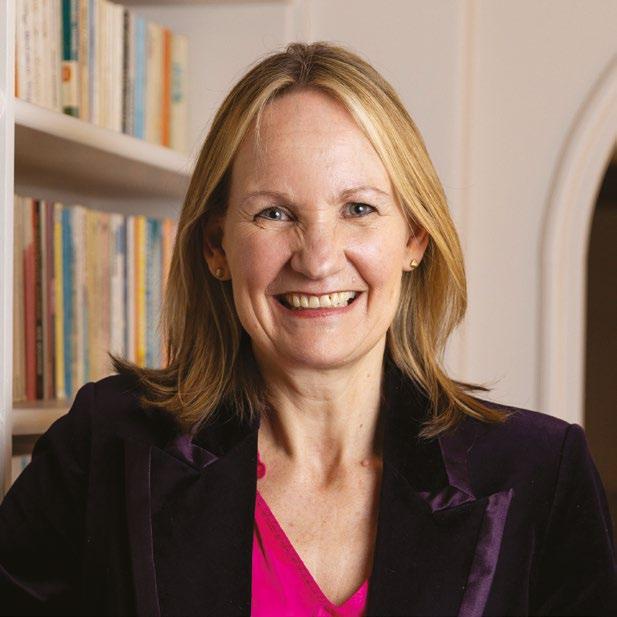
“By the start of 2025, there were more than 142,000 professionals listing ‘fractional’ in their LinkedIn job titles”
more than 142,000 professionals listing ‘fractional’ in their LinkedIn job titles. A business can find a fractional leader to fill any of the common C-suite positions and work across many sectors. Industries facing the greatest pace of evolution are making the most use of the elastic executive team, including technology, software as a service and healthcare.
Fractional leaders have the greatest engagement from SMEs and startups because of the flexibility to scale involvement according to business needs, supporting growth stages effectively. They can work anywhere, from a couple of days a month to a few days a week, dialling up and
down support as needed. Fractional leadership also offers opportunities for mentoring emerging leaders within the organisation, including business owners and new talent being developed internally.
Large corporations can derive significant advantages from a more elastic executive team, as their complex operational demands often require specialised expertise for specific projects or to bridge leadership gaps temporarily, without the long-term commitment of a full-time hire. Additionally, fractional leaders are typically committed to their portfolio careers, ensuring they do not seek permanent positions within the organisation. This reassurance allows existing leaders to delegate responsibilities confidently, maintaining control over strategic direction. Contracts can be structured with defined durations, providing further flexibility.
Fractional leadership presents a compelling alternative to traditional full-time C-suite appointments for businesses aspiring to grow and evolve. It offers cost efficiency, expertise and adaptability for organisations of all sizes. Incorporating fractional leaders into your strategic planning can help address critical challenges, including skills gaps and succession planning, while supporting sustainable growth and innovation.
Sara Daw is group CEO of The CFO Centre and The Liberti Group, and the author of Strategy and Leadership as Service – How the Access Economy Meets the C-Suite, which explores the fractional leadership trend.
Gordon Smith, FIoL and founder of Lightning Leadership

1
What does leadership mean to you?
After more than 30 years leading teams, from my early days in the RAF to senior roles in the global tech sector, I’ve learned that leadership isn’t about rank or rules; it’s about making people visible, taking action and building trust at every level. I focus on spotting potential and making sure every voice is heard. True leadership means setting high standards and showing people they matter, especially when the pressure is on. Putting people first does more than lift morale; it creates results that last and teams that pull together.
2
What are your main leadership and management challenges?
My biggest challenge is making sure no talent is overlooked, especially when teams are working remotely. At software provider Rimini Street, I kept 670 support engineers – across four continents – engaged, recognised and valued. This approach delivered a 94% retention rate and outstanding results for our clients. At Lightning Leadership, I mentor leaders, from newly promoted managers to senior executives, encouraging
organisations to move beyond boxticking promotions. I ensure people are supported and developed at every stage. This way, people don’t just stay; they contribute fully and help teams become the backbone of a strong, competitive business.
3
How does the landscape of your sector affect those challenges?
Technology and consulting never stand still. Work is global, remote, and the pressure is relentless. In this climate, even the best people can feel like just another cog in the machine if leaders are not proactive. I have seen how easy it is for people to become invisible, but have tackled it with mentoring, regular recognition and a culture that values loyalty. At Rimini Street, our strong retention rate proved that investing in people delivers real business results. Now, I help leaders protect engagement and trust, so teams stay resilient and clients remain loyal.
4 What are you focusing on from a leadership and management perspective?
Building leaders who can adapt, inspire and respond to the realities of
modern work. The Harber Helix – a toolkit for mentoring and leadership –draws on three decades of hands-on experience. It rejects rigid, off-theshelf training and, instead, adapts to real lives and challenges, from neurodivergent thinkers to seasoned leaders. I empower leaders to turn setbacks into progress and complexity into loyalty, driving results that can be felt throughout the organisation.
5 How do you develop your people?
I believe in tailored development, not one-size-fits-all templates. My first step is to find out what drives each person: their ambitions, challenges, and where they want to grow. I listen carefully and adapt my mentoring. Alongside honest feedback, I have found a bit of banter goes a long way; it helps build genuine relationships and eases tension when the pressure is on. Some thrive on ambitious goals, others benefit from thoughtful encouragement, but everyone wants to know their progress matters. I create opportunities that unlock potential and deliver meaningful results for the individual and the business.
6 What is your biggest leadership lesson over the past year?
That real leadership is all about presence and action. No strategy or technology can replace a leader who steps in, pays attention and does what is needed when it matters most. I have seen whole teams rediscover their energy simply because someone took the time to connect and offer genuine support. Mentoring and true visibility unlock loyalty, resilience and results. Leadership means turning up, especially when times are tough, and making sure everyone knows they matter. Teams always go further when you are out in front with them and not watching from the sidelines.
We’re looking for members to feature in the Hot Seat! Email louise.parfitt@ cplone.co.uk


As a leader of a recruitment charity and an organisation that supports corporates to live out their social value ambitions, Emma Freivogel is challenging bias in the workplace, in the boardroom and in society as a whole
Writing Louise Parfitt
Photography Ian Farrell
“Ispent about 17 years fighting for the underdog in a lot of different capacities before setting up Radical,” Emma Freivogel tells me as we sit down to chat in the Sage office in the Shard – space gifted to Radical to use for meetings such as ours. The view from the 17th floor is dramatic – London sweeps before us in a medley of grey spires, shiny high-rises, fuzzy green areas and brown-brick low-rises. It feels a long way up from the streets below, but that is precisely where Radical is making the difference.
There are two businesses under the Radical brand. “Radical Recruit is a charity that places people into jobs,” Freivogel explains. In essence, it is a social recruitment consultancy that works with people from marginalised communities who are underrepresented in the jobs market – for example, people who come from a protected class, such as women, disabled people, young people and the queer community. The charity also works with people who have had adverse life experiences, such as homelessness, or who have had contact with the criminal justice or care sectors. The charity also works with people who have experienced domestic abuse, or are solo parents.
Then there is B-Radical, which was, Freivogel says, born out of necessity. “We became painfully aware that there is no shortage of employers that say they want to do the right thing and recruit radically. There’s no shortage of ‘Radicals’ [a term Freivogel uses to describe her clients – and anyone who has faced and overcome adversity] to place into those jobs, but employers are
simply not ready – they are not empathising with the barriers our candidates face, which could be anything from financial hardship to domestic violence, and everything in between. We set up B-Radical to offer support to corporates in the form of training and consultancy – turning their diversity, corporate social responsibility and social value rhetoric into meaningful action.”
Radical is supported by a network of 900 volunteers – including organisations, such as Sage, that wish to use their privilege for good – a board of trustees and a pro bono leadership team. There are three paid members of staff.
Radical’s beginnings came from a firing, a wallow in self-pity, and a kick up the backside from Freivogel’s mum, and co-founder of the charity, Jude Smith.
Freivogel had been working for an organisation that supports women coming out of prison to reintegrate back into the community. In two years, she and her team helped 400 women to find work. But a few things didn’t sit right.
She became acutely aware of the fact that most of the women were going into jobs that they didn’t really want and that other British people didn’t want to do. “Think back-of-house at Pret or seasonal fruit picking – jobs that don’t pay a living wage, certainly not in London,” Freivogel says.
“I met loads of women who had come from corporate backgrounds and who had university degrees, but who had done things under duress –usually because of the men they were involved with – that landed them in prison. They were very capable, but we weren’t brokering opportunities for them. The model, put simply, lacked aspiration.”
Another thing she observed was that the third sector is full of people who are well-meaning and want the best for the communities they’re supporting, but who don’t understand the mechanics of recruitment. “They’ve often not worked in big corporates, therefore they don’t appreciate the different barriers and motivations that hiring managers and HR professionals experience when it comes to recruitment. They don’t work at a pace; there’s no sense of urgency. They’re not properly vetting and qualifying the candidate, the vacancy or the employer. And the people we work with need so much more out of an employer than ‘just enough’.”
Freivogel also wanted to expand the support to include men coming out of prison – because, as she says, this is where the bigger issue lies: in the UK, the female prison population is less than 4,000, whereas male inmates number closer to 90,000.
Freivogel is not one to mince her words. She told the newly appointed CEO her plan was to set up her own charity, doing similar work, but doing it differently and for more people. That wasn’t well

“We became aware that there is no shortage of employers that say they want to do the right thing and recruit radically”
received by the business and she was “basically sacked on the spot”.
Feeling sorry for herself, she called her mum who lovingly told her to stop moping and get out there to do this thing she was obviously meant to do. She lent her some money to get it off the ground –and Radical was born.
Then the Covid-19 pandemic hit and recruitment in the UK all but ground to a halt. “As if trying to get work as an ex-offender or homeless person isn’t hard enough, suddenly there is another barrier – absolutely no-one was recruiting,” Freivogel says.
In 2021, the government announced the ‘Everybody in’ campaign, to accommodate homeless people and get them registered with a GP. Freivogel was approached by the homeless charity St Mungo’s, which had been commissioned to work with 65 men and women who had come off the street as part of this campaign.

“Most didn’t speak much English; some had been on the streets for 10 years and were entrenched in homelessness,” she says. “But they were given the opportunity to take some respite from their lives and were wrapped in support. We placed 45 of 65 into work: two years on, 35 of them were still in work. That project proved our model works, because we managed to help 45 people solve their homelessness, we worked with some amazing big hitters such as Compass Group in the facilities management sector, and we created a whopping £2.5m in social value while spending less than £400,000 on the scheme itself.”
This was when I first became aware of Radical: a client I was working for was recruiting people who had been homeless into frontline roles via the Radical Recruit team. Freivogel’s drive, passion and belief in what Radical is doing is as strong now as it
The brand is inspired by a woman I met in the first couple of weeks in my previous role, who is called Chan. Her parents belonged to rival gangs and she has something like 16 siblings.
The things that happened to her, you don’t see them in horror movies: she had knives held to her throat, she had to prostitute herself out just to eat, she was used to run drugs and hide guns. Her first conviction for weapons was at age 12 and she has 147 convictions in total. When I met her, my job was to cobble together a CV for her and convince someone to interview her before she left prison.
The only thing she wanted to do – that she knew how to do, because her grandmother had taught her – was cook. She had started a catering business in prison for events that took place inside and outside of the prison. I invited her to meet one of our employers, a guy called Oli, who was head of people at Honest Burgers at that point. He tried a piece of her carrot cake and said it was the best he’d ever tasted! He was opening up a new restaurant and invited her to come for an interview when she was released from prison –she got the job.
We have just placed her again, in a head chef role in a fancy London pub earning £70k. And it’s people like her – who, on paper, don’t have a hope in hell, who don’t fit anyone’s expectations, who don’t believe in themselves – that’s why we do it.
was then – in fact, maybe even stronger, because she says the world seems to have got worse; there is less kindness, more individualism.
“Diversity is a dirty word at the moment,” Freivogel says. “We don’t even use it in our marketing campaigns now, because it’s not front and centre in people’s minds. We’ve done a whole move around repositioning into the social value space, because businesses do not want to talk about diversity any more.”
This is where Freivogel’s leadership comes into sharp focus. She doesn’t simply identify gaps – she builds the mechanisms to close them, quickly and credibly.
At the heart of B-Radical is a commitment to making the corporate social value agenda more than just a tick-box exercise. Under Freivogel’s direction, the consultancy partners with companies to turn their social value frameworks and environmental, social and governance (ESG) ambitions into meaningful outcomes. In Freivogel’s words: “We bridge the space between ambition and delivery.
“What we are seeing now are changes to the Social Value Act and the Procurement Act,

The best lessons I’ve learned are not from the wins; they’re having the hard conversations, fighting the battles that no-one else sees. It’s in the really challenging times where you’ve got to make awful decisions that you hate, that just go against the grain or feel really hard to make – that’s what really shapes you as a leader.
Because we employ Radicals too, a lot of the work we do with our candidates we’re doing with our
team. We attempt to create traumainformed places of work, where people have a voice and can speak truth to power if they feel they need to. And I’ve learned that, when you do that, people stay longer, they are more loyal, they feel more in control, they’ve got more choice and more agency, and they’re happier. For me, leadership is about giving people the tools, encouragement, courage and support to go and do their jobs well.
“That project proved our model works, because we managed to help 45 people solve their homelessness and we created a whopping £2.5m in social value while spending less than £400,000 on the scheme itself”
and so on,” Freivogel explains. “The government passes on the responsibility for making the world a better and fairer place to those who bid for government contracts. Then the big players delegate the responsibility down even further until you get to the facilities company that’s providing your corporate cleaning and hygiene services. To bid for contracts such as these, you have to demonstrate social value, which is basically the value you deliver in addition to what you’re contracted to do that’s good for people, planet or place.
“We help organisations embed diversity, equity and inclusion into their operations in ways that are measurable, commercially smart and aligned with social value frameworks. We don’t just advise, we deliver. That means real people into real jobs, with recruitment and retention outcomes that outperform the market. More than 90% of the people we place are still in work six months later. Our model wins bids, strengthens supply chains and proves an organisation’s commitment to ethical, inclusive business.”
Freivogel gives the example that to keep someone in prison for a year costs around £60k. “That’s a really conservative number – you can imagine if someone has committed several crimes, they have been in and out several times, then there’s the judicial process, plus the cost and impact of the crime, etc. And, in prison, very limited rehabilitation happens, unless you are on a long sentence. So, for someone like Chan – a woman who had 147 convictions by the time I met her and who is the inspiration for our mission – the cost to the public purse was up in the millions. I can evidence that we’ve created a minimum of £20m worth of value in the past five years, yet I’ve spent less than a million pounds in doing that.”
As a leader of an organisation that is championing some of society’s most vulnerable people in a world full of systems, structures and attitudes that are stacked against them, Freivogel has more than her fair share of challenging days. Radical becomes a
lifeline to those it supports, and the team are often involved in the details of people’s lives that go way beyond a job – housing issues, financial worries, mental health crises – often taking messages and calls at times when most of us have switched off from the day job.
“If you think about fracturing your leg, then you fracture the same leg again and again, eventually you’re not going to be able to walk on that leg; it’s too painful. And that’s the same with the trauma that so many of our Radicals have experienced. A lot of the people we work with have backgrounds that break my heart, but they’re also amazing people, with huge potential. They just need a chance to prove it.”
I wonder how the Radical team, who are supporting people who have experienced so much trauma, process and cope with what they are hearing about almost daily.
“It can be tough,” says Freivogel. “It sounds clichéd, but it is really important to fill your own cup.
“We’ve got an amazing woman called Dr Darshi, who is a psychologist and provides pro bono talking therapy to the team, our volunteers and our Radicals. Every month, the staff have a ‘Radical bank holiday’, where they get a three-day weekend just to go and completely switch off. I am thinking about the more formal structures we need in place to do more around this, too, including exploring clinical supervision – because we’re doing work that requires a huge amount of expertise, and it can be dangerous and harmful if you’re not debriefing people properly.”
Freivogel pauses. “How I do that – fill my cup – I am still working that out,” she says, while admitting she does not take a monthly three-day weekend herself. “I have recently brought on some incredible humans who are far more intelligent than me and know different things from me. And they have opened my mind to do things differently, as well as taking some of the
My mum is a proper radical. She was born into poverty – youngest of seven kids, her parents came over to Australia from England and weren’t treated very well because they were different, I guess.
My nan had undiagnosed bi-polar from the sounds of it, and died by suicide, so my mum carries a lot emotionally. She didn’t have any qualifications and worked in a factory until she met my dad. He came from a world in stark contrast to hers: an only child with two parents in work, university educated, etc – and they had me!
I was always taught by my parents what’s right and good. We never had explicit conversations about privilege or using it to help others, but I always understood what it was – and that I had a lot of it. So when I saw opportunities to do something useful with it, I just thought, why not? I don’t have any grand qualifications; I messed around at uni and ended up dropping out. I worked in care, starting in support roles that quickly turned into team leadership and then management. After that, I did a 10-month stint at a recruitment company.
Eventually, I hit a point where I thought, I need to get out of here, because it just wasn’t fulfilling. So I headed to Europe, and had the best time going to festivals, spending too much money and generally having a ball. I landed in London, worked for a couple of years, and then set up Radical in 2019… and here we are today.


This is hard to pick, because we’ve made so many great placements. Steve [pictured here with Emma], is one character who stands out. He is cheeky, but he has a good heart. He was on the streets for 30 years; in a nutshell, he was abused in care and turned to drink and drugs to numb the pain.
I met him when he was in his 50s, and he had hundreds of convictions. He reached out to me because his cashin-hand work had dried up, the police had towed away his caravan and he was desperate.
I got him through our programme to get him ready for work and we raised a heap of money for him to get into private accommodation. Then he got his first proper, ‘on the books’ job, with a charity doing grounds
maintenance, and he has now gone on to a new job doing homeless outreach for another charity. There’s also a young care leaver who we are working with at the moment, who has a baby in care currently, because she couldn’t look after her. She desperately wants a job – and recently one of my team called me to say that the girl is absolutely buzzing because her trial shift at John Lewis went well, and she’s been told she is getting a house and is now planning how to make the house toddlerproof. Now she’s thinking like a mother because she’s got a job, a roof over her head and she will be able to bring her baby home – the things that so many of us just take for granted. Makes me want to cry thinking about it. But, yeah, things like that happen every day.
weight off my shoulders. And being honest with my colleagues: if I need to go for a nap during the day because my brain is fried, I tell them – and that gives them permission to look after themselves at work, too.”
Three years ago, Freivogel burnt out. She says was so tired that she could barely string a sentence together, but she kept showing up because she thought “that’s what good leaders do”. But it got to the point where she had to be signed off work,
so she went back to New Zealand to stay with her mums – Jude and Suz – to rest and recoup. “But in showing that vulnerability to my team, in saying to them, ‘I am broken right now’, they really stepped up. That has been a really proud moment, personally, to see them do that and own it. It’s also been a defining moment for me in my leadership journey. I’m a much better leader now, in the sense of giving them ownership to let them get on and not try to control everything.”
But learning to let go when it is your company – your baby – is something Freivogel is still working on. Recently, she set up a follow-up meeting with a client – a task one of the Radical partners had said he would do – and he gave her a firm telling off. “I told him it was no big deal – he’s working pro bono on top of his day job, so I just did it myself. But the client said, ‘Em, you’re a female CEO working with a lot of men in corporate leadership. If someone they see as your subordinate doesn’t do something and you step in, especially something like admin that could have waited, you’re reinforcing the very barriers you’re trying to break. Whether you like it or not, that’s how people think.’”
She smiles. “Basically, he was telling me I need to start acting more like a male CEO. This was a profound moment of male allyship for me. And we all need people like that around us – whether we are leaders or not.”
With our time nearly at an end, I ask Freivogel what change would bring about the most benefit for her and the people with whom she works.
“One practical thing that would really help is if all of these ambitions that organisations speak of in terms of ethical business, and diversity and social value, were somehow linked to employee bonuses. If the people at the top – the ones who hold the budgets and make the decisions – need motivating, money will be the driver. If earning your bonus depends on it, you need to clearly show how your work aligns with specific values and KPIs. If that were the norm, the world would look very different and, I suspect, every single one of us would be happier.
“Good businesses can do that. The business community collectively, globally, is the biggest, most powerful community to elicit any change in the way we view Radical people, poor people, and treat them and respect them.
“Broadly speaking, what I’m saying is that the people at the top need to be more able and willing to share the pie.”
Louise Parfitt is the editor of Edge

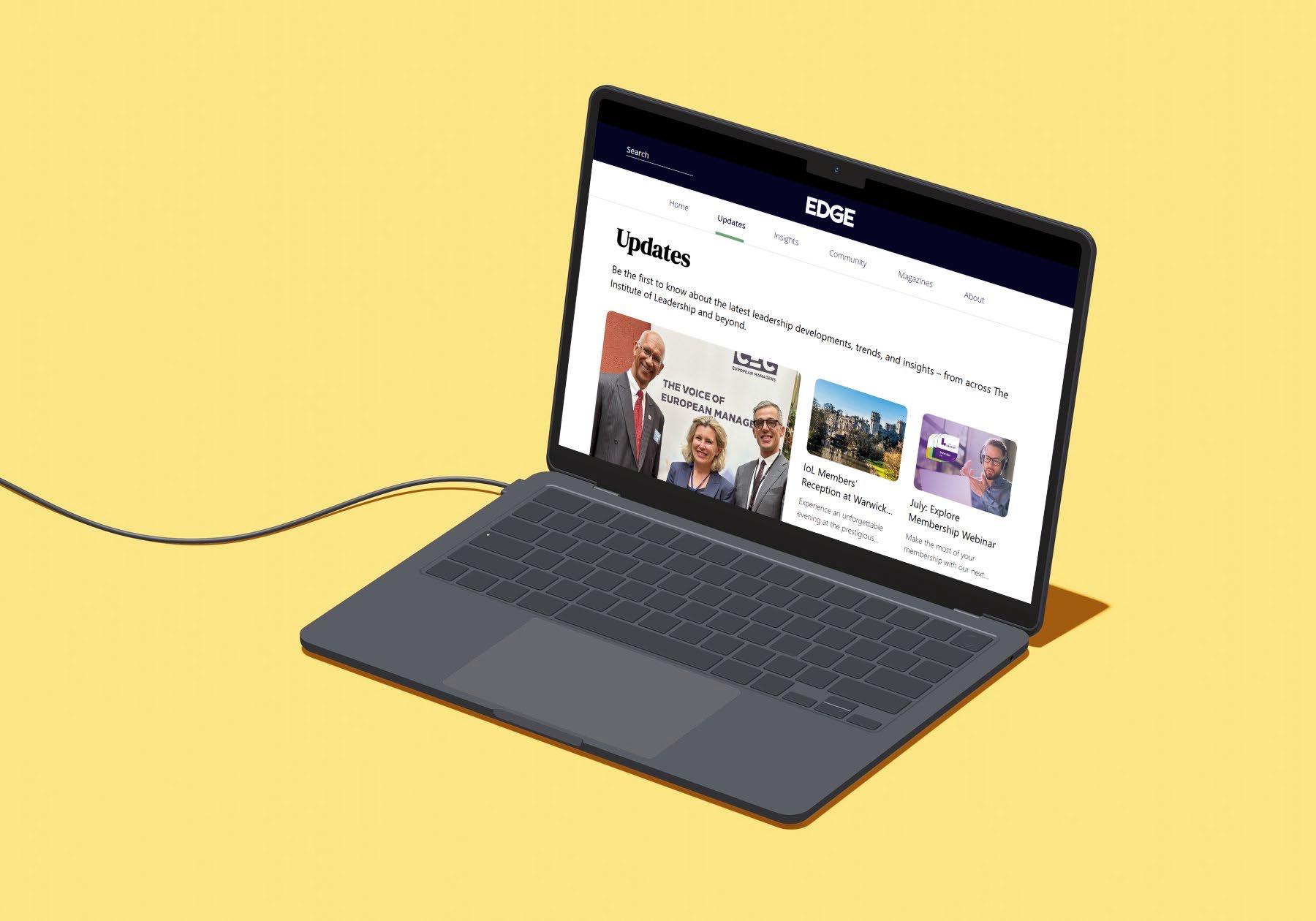



Dr Debbie Bayntun-Lees on the urgent need for leaders to do more than support equity in principle
Allyship is no longer a ‘nice to have’ in the toolkit of leadership – it is a defining competency for those navigating increasingly diverse, complex and value-driven workplaces. As our world grapples with inequality, polarisation and systemic resistance to change, we urgently need leaders who do more than support equity in principle. We need leaders who practise it in action.
Allyship is a dynamic, relational process of leadership grounded in empathy, accountability and action. For global leaders, it involves continuously challenging systemic inequities, fostering inclusive cultures and advocating for marginalised groups, especially in contexts where dominant norms discourage vulnerability and reflection. Effective allyship requires a mindset shift from passive support to active partnership, integrating self-awareness, psychological safety and organisational influence to drive sustainable, context-sensitive change.
This article draws on recent research carried out by myself and Ghada Howaidy across Europe and the Middle East and North Africa region to explore how men, particularly those in leadership, experience and evolve through the allyship journey.* The work reimagines allyship not as a fixed destination, but as a mindset – a ‘becoming’ process with distinct emotional and cognitive shifts.
At the heart of this research is the Gender Equity Mindset Model, which traces men’s allyship development across four stages:
● Apathy
● Ambivalence
● Reflective and responsible
● Energised and motivated. The model provides a practical diagnostic framework for leaders to assess where they and their organisations currently stand in the allyship journey.
1
Apathy: It doesn’t affect me
In this mindset, allyship is seen as irrelevant, even threatening. Dominant narratives include a fear of ‘positive discrimination’ or beliefs that equity is ‘already achieved’. This zero-sum thinking reflects detachment and organisational cultures that reward stoicism over empathy.
2
Ambivalence: I’m unsure what to say Here, leaders may express support for equity, but hesitate to act because of fear of backlash, discomfort or confusion. This stage signals cognitive dissonance: the recognition that something is wrong, but a lack of confidence in how to respond.
3
Reflective and responsible: I want to do more Men at this stage have typically encountered equity through personal relationships or organisational interventions. They demonstrate emotional empathy and a sense of personal accountability. Yet they often seek structured ways to translate awareness into action.
4
Energised and motivated: I am an advocate
This stage embodies relational leadership. Men here act as mentors, advocate for policy reform, and champion inclusion with emotional intelligence and credibility. These leaders often credit cultural shifts and safe spaces as catalysts for their transformation.
The role of emotion: a new data lens
Men’s emotional responses to gender equity were captured using word-cloud analyses. The findings were revelatory: far from being apathetic, many men felt frustration, sadness, fear, confusion and, in some cases, deep empathy and protective instincts. The leadership implication? Creating space for men to explore their feelings safely is a vital first step in activating meaningful allyship. Emotional intelligence is not just a ‘soft skill’; it’s an equity tool.
Barriers to male allyship in practice
The research identifies recurring blocks to allyship:
1Cultural conditioning: masculinity norms discourage vulnerability, reflection or seeking help.
2 Structural blind spots: men are often unaware of policies or equity strategies.
3Fear of missteps: many men avoid engagement out of fear of ‘getting it wrong’. But these barriers are addressable. The key lies in offering context-sensitive interventions aligned with each stage of the mindset journey.
Modelling allyship at the top
The research offers tailored interventions to move men along the allyship continuum:
Mindset stage Primary need Recommended interventions
Apathy
Awareness, empathy
Ambivalence Clarity, confidence
Reflective and responsible Safe practice, skill building
Energised and motivated
Leadership and systems impact
Reflective quizzes, storytelling, inclusive business-case data
Peer-led discussions, scenario-based workshops, visible role models
Advanced training, mentoring circles, allyship coaching
Inclusion task forces, advocacy programmes, reverse mentoring
Each phase requires a shift not just in learning content, but also in tone, language and psychological safety. One-size-fits-all DEI training rarely works.
In one global engineering firm, a female engineer expressed frustration after being asked to join a client presentation ‘for diversity optics’. Her technical capabilities were sidelined, reinforcing tokenism. Her manager could have used that moment to publicly affirm her skills and align her presence with business value. That’s the difference between performative inclusion and relational allyship.
Allyship as leadership in a ‘becoming’ world
Allyship is not a badge, it is a practice. A leadership practice. It calls on us to move beyond performative support and towards relational accountability. For male leaders, it means unlearning silence, rethinking privilege and seeing vulnerability not as weakness, but as a form of strength. For organisations, it means creating cultures in which allyship is systemic, not symbolic. Because, ultimately, allyship isn’t just about gender equity; it’s about building workplaces where everyone belongs, thrives and leads with courage.
Dr Debbie Bayntun-Lees is professor of leadership and organisational development at Ashridge Hult Executive Education, Hult International Business School.
*Bayntun-Lees, D. & Howaidy, G. (2024) Towards Gender Equity in the Workplace – What Do Men Need to Take on the Role of ‘Ally/Partner’? ICERI2024_2756. Conference Proceedings. iStock
Our research confirms that authentic leadership is the lynchpin of allyship progress. Where senior leaders model vulnerability, acknowledge privilege and participate in equity programmes, cultural transformation accelerates. Conversely, performative gestures without follow-through erode trust.
Laurence
and why leadership matters more than ever
For years, company leaders have operated with a degree of reassurance that unless they personally approved misconduct, their organisation was unlikely to face criminal charges. That long-standing comfort zone is now being eroded.
In October 2023, a major piece of legislation came into force that significantly broadened the scope of corporate criminal liability. The Economic Crime and Corporate Transparency Act (ECCTA) makes it easier to prosecute companies for financial wrongdoing, and its implications reach far beyond regulated sectors such as banking or insurance.
Senior leaders in all industries now need to understand where the new risks lie and, more importantly, what they are expected to do about them.
For decades, UK law made it difficult to hold a company criminally liable for the actions of its staff unless those actions could be attributed to a ‘controlling mind’. In practice, this meant that, unless a board-level executive or company director personally committed the offence, the organisation was typically in the clear.
This concept, known as the ‘identification doctrine’, created a high barrier for prosecution and effectively protected companies from liability when wrongdoing occurred further down the hierarchy. That began to change gradually.
The Corporate Manslaughter and Corporate Homicide Act 2007 introduced liability where a senior manager’s gross breach of duty caused a death. The Bribery Act 2010 followed, creating a new offence for commercial organisations that failed to prevent bribery, unless they had ‘adequate procedures’ in place. Although significant developments, they are still relatively narrow in scope.
The ECCTA builds on this approach and brings about two important changes. First, the act introduces a new ‘failure to prevent fraud’ offence, which requires large companies to take steps to prevent fraud by employees, agents or contractors.
Large, in this context, means meeting two out of three thresholds: more than 250 employees, more than £36m in turnover or more than £18m in assets.
The logic is clear. If a fraud is committed and the company did not have reasonable preventative measures in place, then the company itself may be prosecuted, regardless of whether leadership knew what was happening.
Second, and even more wide-reaching, is Section 196 of the ECCTA. It applies to all businesses, regardless of size, and states that a company can be found guilty of an economic crime if a senior manager commits the offence while acting within the scope of their role. The definition of a senior manager is broad, covering anyone who plays a significant role in managing or organising the business.
This means a regional director manipulating invoices, or a head of procurement engaging in fraudulent supplier relationships, could now expose the entire business to criminal charges. It no longer
matters whether the board was aware or complicit. It matters that someone in a position of authority, while performing their role, committed a crime.
The leadership response
This shift raises a critical question for C-suite leaders. What does a proportionate and effective response look like?
First, it is essential to recognise that the law does not require perfection, just reasonable prevention. The courts will consider whether your organisation took appropriate steps to prevent fraud and other economic crimes. If the answer is ‘yes’ and you can clearly demonstrate that, you have a defence. If not, there may be trouble ahead.
Leadership teams must do more than sign off on anti-bribery policies or delegate compliance to a junior team. It means embedding clear expectations into contracts, policies, training and culture. It means having effective internal reporting mechanisms and asking whether the right checks are in place when decisions are made on pricing, procurement, subcontractors or financial authorisations.
Second, there is a cultural dimension. Many firms have long treated compliance as a legal necessity rather than a leadership value. However,
“Leadership teams must do more than sign off on antibribery policies or delegate compliance to a junior team. It means embedding clear expectations into contracts, policies, training and culture”
the tone from the top under the new framework is no longer optional. If your managers do not understand what is expected of them, or if they believe shortcuts will be overlooked in the name of performance, the risk is no longer just reputational. It is criminal.
Third, there is a broader trend to consider. The Crime and Policing Bill, currently before parliament, proposes to expand this principle even further. If passed in its current form, the new law would make companies liable for any criminal offence – not just economic crimes – committed by a senior manager while acting in their role.
This may include harassment, data misuse, unauthorised surveillance or other criminal conduct. It is a clear signal that the government and regulators are moving towards greater corporate accountability in every area.
The reality is that most senior teams already operate with integrity, and what is needed now is to back that culture up with processes, training and documentation that show regulators the business takes its responsibilities seriously.
This might mean conducting a fraud-risk review, updating employment contracts, reviewing linemanagement training or refreshing whistleblowing procedures. It might also mean ensuring that middle managers can identify and escalate concerns, rather than handle them informally or overlook them.
It is often said that leadership is about setting the tone. Under the ECCTA, it is also about setting the controls, the expectations and an example. Because if a senior member of your team goes offpiste, the law may not just ask what they did – it will ask what you did to prevent it.
Laurence Howland, lead consultant of How Compliance, is director of risk and compliance at Buckles Law, prior to which he spent three years as a senior financial investigator with the Solicitors Regulation Authority. He served 30 years with HM Revenue & Customs as an accredited financial investigator and, from 2010-14, was the UK’s fiscal crime liaison officer appointed to the British Embassy in Beijing.
Ad Davies, former head of talent development, performance and culture, and internal communications at Gymshark, chats to Louise Parfitt about lucky chances, high performance, career achievements – and how to hold on when your world gets turned upside down
Ad Davies and I have been trying to arrange an interview for the best part of six months. We finally catch up at Leadership Live in June – the day after he left Gymshark to follow his dream to start up his own business. Once we get talking, I realise that it wasn’t just work demands on our time that delayed our chat: Davies has had a turbulent few months in which he celebrated the arrival of his son, set up his own business, and was diagnosed with epilepsy.
“I felt like my world had collapsed when I suffered my first epileptic fit just two weeks after my son was born,” he says. “I went through the whole cycle of ‘how can this be happening to me, right now?’. Then I began to reassess my lifestyle.”
Davies’ epilepsy happens during sleep, which his neurologist thinks is linked to the sleep disruption a new baby can cause. “There’s something in my subconscious that means my fits happen between 10pm and midnight, and 5am and 7am,” he says.
“I have always been the two-job guy, constantly on the go – and this is a sign of burnout because I have tried to take on too much. I think it comes from watching my parents do everything they could to put food on the table and make a better life for us –I guess I have taken on the good and the unhelpful stuff from that upbringing, and it all just reached a point where my body was like, ‘it’s too much’.”
first
During this time, Davies was fully supported by his Gymshark colleagues and cited a values-driven approach being key to this. He refers to the people he worked with several times throughout our
chat, with respect and genuine fondness. “My bosses there, Sian Keane, Ben Francis [Gymshark founder and CEO] and Noel Mack [Gymshark CBO], as well as former bosses Dave Parry and Emma Brundrett, have really looked after me in the past seven months when I have had these huge challenges,” he says.
Davies joined Gymshark in 2018, when the brand was beginning to experience huge commercial success and had just moved to its current headquarters in Blythe Valley Business Park, Solihull.
“I was a big fan of Gymshark – I was into exercise and fitness, and spent a lot of time in the gym, so I was their target market,” Davies smiles.
He was working two jobs at the time – one at factory automations company Fanuc UK and one as an academy coach at Leicester City Football Club. Through a connection – Beth Armstrong – at the latter, he got chatting to someone from Gymshark. “They invited me to meet Ben and the team, who then offered me two weeks’ internship.”
Gymshark founder Ben Francis built the brand from his parents’ garage. With a passion for fitness, and seeing a gap in the market for good-fitting gym wear, he began sewing, screen printing and delivering fitted, aesthetic gym apparel in 2012. Brand awareness took off
after bodybuilding athletes tried his clothes and began sharing them with their communities. From there, the business grew. The brand has expanded into women’s clothing, content creation and events, and has customers around the world, with offices in several countries.
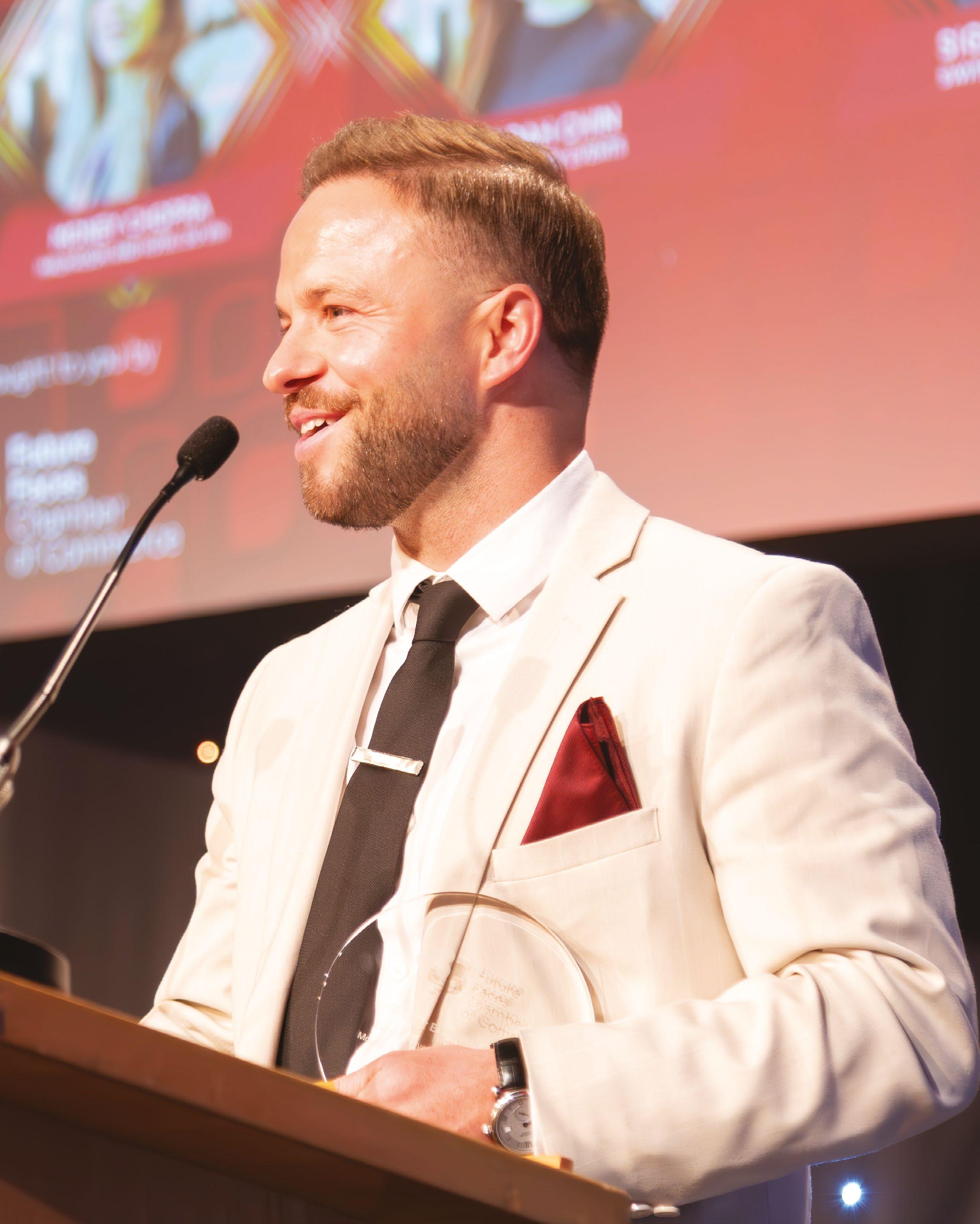
“Gymshark taught me the importance of feeling safe to push myself out of my comfort zone and take bold decisions”
“I am indebted to a lot of people; I have had some incredible leaders who have guided me”
Davies pauses. “I am indebted to a lot of people; I’ve had some incredible leaders who have guided me. My boss at Fanuc UK, Kerry Booth – who was the HR manager for the UK – said to me ‘go, you’re passionate about this, so take this opportunity’. I look back on it now and think how rare it is that people get that sort of backing.”
At the end of the two weeks, Gymshark offered Davies a role as its people manager. “I started under the tutelage of Dave Perry and Emma Brundrett, and worked closely with Ben –it’s been a real privilege.”
Gymshark employed approximately 150 people when Davies started. It now employs more than 800 and has spread across the world, so he was there during an incredible period of growth.
“Gymshark products are born out of purpose and are always so innovative. It’s able to transition so quickly and grow because there is an appetite for risk, and the culture is such that there is no fear of failure – they are not scared to say ‘we got something wrong, let’s go back and start again’,” Davies explains.
“Often, companies have that element of risk-taking in the beginning, but as they grow and more people are involved, it can get lost. But Gymshark has kept that appetite for risk at its core and that differentiates it from the competition.”
From people manager, Davies moved into the roles of development manager, people development partner, and then head of talent development, performance and culture, and internal communications.
I am getting married in September, to my partner Elizabeth. I am so looking forward to it. I think of everything she has dealt with in the past year – from our house renovation to having and looking after our baby boy, and then dealing with my epilepsy diagnosis just
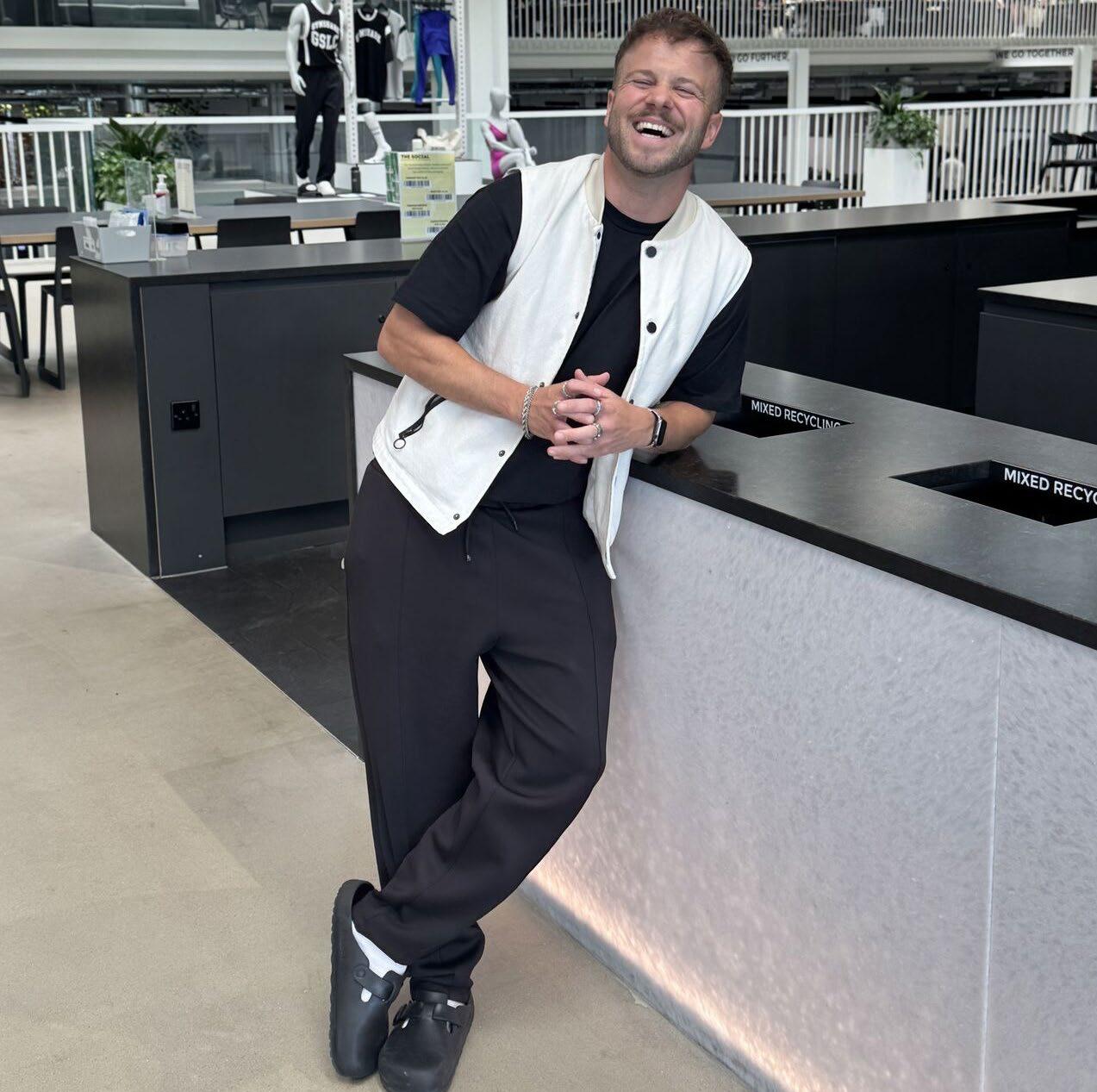
Ad Davies credits Gymshark with giving him the opportunity to chase his dream
two weeks after having our son – and she’s been so strong. You don’t have to just take leadership lessons from people standing up on a conference stage or in a boardroom. There are leaders everywhere we look in life, in different forms.
“The latter was a change I asked for, because I could see how the market and landscape was going, leadership wise,” he says. “There’s massive ability to influence the cultural landscape of the company through learning performance.
“I ran a talent function for a period of time and spent six months with a team in Denver, Colorado, as we transitioned the offices from Denver to New York. My focus is the people and cultural side of the company, and at the core of that is always making sure people understand why we are doing something, so they feel ownership of it.”
Embracing the difference
Davies has always had a strong appreciation of diversity in his team because “if you are surrounded by people just like you, you aren’t challenged as much. We should be encouraging more people to come to the table with difference of thought, difference of ideas. You need to be comfortable to surround yourself with people who don’t look, sound and think like you, and who haven’t been brought up in the same manner as you.”
This is something that resonates with Davies on several levels. He once received some pretty challenging feedback from his team during a performance review at Gymshark. He asked them to put their names next to the comments if they felt comfortable to do so, and invited them to have an honest conversation to explore what needed to change.
“If I had surrounded myself with an echo chamber of people who always said ‘great idea, Ad’ then, at some point, I’d have realised I can only get so far. I always ask people, ‘are you giving your team enough opportunities to challenge you?’ Especially now, with the evolving technological landscape and AI coming into play –it is more important than ever to lean into people and ask for their opinion and ideas.”
Davies is also aware that what he does is very different from the jobs his parents did –to the extent that he can’t really talk to them about his work, because they have no concept of what he does.
“My family’s background is firmly working class,” he says. “My dad grew up in a house with 11 or 12 other people. He had a pretty rough upbringing because of that. To this day, we can’t have a conversation around work, because I don’t think either of my parents would be able to articulate what I do on a day-to-day basis. But they are who taught me about resilience, acceptance and being open to difference.”
Davies, his twin brother and his sister went to the local state school, which was in special measures for years and, he says, was a tough environment. “There wasn’t much regularity in terms of teaching staff, but those teachers that were there for the long haul taught me more about leadership than I really appreciated at the time –about perseverance and seeing beyond the initial impressions. I also learned how to communicate with a range of people.”
Davies went on to study sport at North Warwickshire and South Leicestershire College. He then signed up for an electrical apprenticeship, but failed, so “I basically followed a girlfriend to university – I was the first in my family to go. But it was the best thing I ever did! I studied coaching and development – there was a sporting bias, but I found the psychology side of it really interesting. It enabled me to take those lessons from sport into business.”
After university, he started a small business with a friend, offering sports coaching in the local area. “I was working with young people in an underprivileged area in Coventry. That taught me a lot about learning where people are coming from, listening to what they have to say, and forging a connection with them in order to be able to train them or teach them, or work with them.”
The next chapter
From there, Davies went to Fanuc UK and Leicester City FC, and then Gymshark, where he stayed for almost seven years. He has recently
For me, the three most important leadership qualities are:
1
Empathy, first and foremost: you cannot educate or lead anybody until you have connected with them. It’s about listening twice before you speak, leaning into people’s strengths, and giving them clarity and direction.
2
Resilience scalability: high performance is not a level you can operate at all of time. I learned this from John Amaechi, who is a British former NBA basketball player and now an incredible speaker – the understanding that there will be dips in performance, as well as peaks, and that’s fine. It’s our job as leaders to make sure that the gaps that happen when people dip below what is expected are shorter and less painful.
3
Results: if you lead with empathy and have a firm understanding of resilience scalability in your team, then you can push for the results.
taken an extended break after leaving Gymshark, to prioritise family, health, his wedding and considering what the future holds.
“I want to work with businesses on their culture and leadership, tying it back to what the business is trying to deliver,” he explains. “I really believe that’s the missing link.
“People talk about HR and everyone having a seat at the table. To me, that’s a non-negotiable if you want to run your business properly. Anything that a people team or a cultural transformation team delivers needs to be directly linked to what the business is trying to achieve. I want to help people and organisations bridge that gap.”
He pauses again. “I have chosen to step away from Gymshark, but I have their blessing. The leadership team has provided me with an opportunity to go and chase my dream. It really demonstrates the culture at Gymshark –it’s empowering.
“A lot of the issues you see in business come from people trying to protect themselves, and that comes from a lack of safety and empowerment. Gymshark taught me the importance of feeling safe to push myself out of my comfort zone and take bold decisions. The leaders at Gymshark lead by giving people permission – because they know, if I have done something, it’s with the best interests of the business or its people in mind. And that’s a mindset I will carry with me through life.
“During the last conversation I had with Ben, I said, ‘it feels scary to say I’m coming away from something I love’. And he said, ‘now’s the time and it’s just the start’. I know it sounds a bit cliché, but if I look at his story, I can believe it –that this is just the start of my next chapter.”

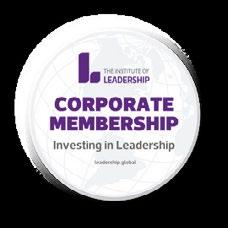



Nicole de Fontaines
As we navigate an era defined by accelerating change, the demands placed on tomorrow’s business leaders are evolving at pace. The leadership landscape is markedly different from even five years ago.
In this climate, specialisation alone is no longer a differentiator, nor is broad management knowledge. The leaders of the next decade must blend deep sector expertise with cross-disciplinary agility, combining technical insight with emotional intelligence and a human-centric vision.
To better understand this changing landscape, CEMS worked with 20 of our multinational corporate partners to explore what skillsets will be required of business leaders by 2030. The findings were striking. Across industries, one message came through clearly: analytical capabilities and business acumen remain essential, but they must now be embedded in a broader, more adaptable leadership framework.
Five key future competencies
1Analytical rigour combined with creativity
While the ability to work with complex datasets is vital, it is creative application that distinguishes high-performing leaders. As automation and artificial intelligence (AI) take over routine data analytics, it will be what leaders can do with that insight that drives real value.
2An entrepreneurial mindset
Static leadership models are becoming obsolete. Leaders must now

operate with agility, ready to challenge the status quo and embrace risk, taking an entrepreneurial approach. As one CEMS partner put it: “They must create the road map, not follow it.”
3Cultural intelligence
The capacity to lead diverse teams is non-negotiable.
Cultural intelligence – the skill to adapt, empathise and collaborate across differences – is fast becoming a defining leadership attribute.
4 Specialisation meets management expertise
Future leaders will be those who couple technical depth with strategic oversight. Whether in fintech, logistics, sustainability or AI, tomorrow’s leaders must combine niche knowledge with a panoramic view of business challenges.
5Digital fluency
In an environment shaped by rapid technological evolution, digital fluency has become a baseline expectation.
Leaders don’t need to code, but they must speak the language of digital transformation and translate it into actionable strategy.
human-centred leaders
Our partners consistently emphasised that leadership success will hinge on values that can’t be automated. These include:
• Resilience and adaptability in navigating change
• Emotional intelligence and humility in building trust
• Values-driven leadership aligning business goals with ethics and impact
• A focus on wellbeing and sustainability, for people and planet. This model of leadership is already influencing how top organisations shape talent. For example, BNP Paribas is committed to future-focused development. “We look for graduates who can ‘connect the dots’ and thrive in cross-functional teams,” says Nicolas Barbier, head of company engagement at BNP Paribas Portugal.
“Success today comes from cocreation, adaptability, and the ability to apply data and technology within diverse, dynamic settings.”
Leadership development is a holistic journey. By cultivating deep expertise alongside inclusive, responsible decisionmaking, we can shape a generation of leaders equipped to meet the complexity of future leadership challenges with confidence and purpose.
Nicole de Fontaines is executive director at CEMS – The Global Alliance in Management Education.
In this series, an emerging leader and their boss talk together about their ambitions and different paths to leadership. This issue it’s the turn of Hounslow Council’s Aziza Anjum (organisational development practitioner apprentice) and Andrew Currie (head of organisational development and learning)

Aziza Anjum (AA): Has there been anything about leadership that has surprised you?
Andrew Currie (AC): Yes, how little organisations do to encourage leaders to be the best they can be! In general, there’s a rush to judge, rather than to support –a culture of quick results and quick judgements – which in a leadership development context is really dangerous because people evolve. Emerging leaders need to feel safe to make mistakes. It’s this whole risk-reward piece, working out what are acceptable levels of risk and saying to your team, “let’s give it a go, and if it doesn’t work out, what can we learn from that?” Really good managers have the confidence to take these types of risks – but of course that can only happen if the culture supports that too, and this is why it’s so hard. Do I think Hounslow has a culture that encourages a degree of legitimate risk-taking? I’d say we are making progress, but we have a way to go.
AA: I agree that the room to make mistakes is important, but so is having your experiences recognised. We are all a mosaic of our experiences and we come to work with a certain persona, but it’s how that’s accommodated that is key. As the youngest member of my team, I feel I bring a fresh insight, a different energy. My team has never shut that down – they have seen it as something to be embraced and to be nurtured. Sometimes I’ve felt I was in at the deep end, but I knew the team had my back, so I have been able to flourish.
AA: What would you say are the main challenges facing leadership?
AC: The number one gap is that we don’t have peoplecentred leadership as a core part of an organisation’s function. Organisations focus too much on short-term planning and are not seeing the role of people and engagement as being their number one priority. If you look at the latest Gallup poll for instance, we are only seeing about 25% employee engagement levels across organisations.* Whereas you want 60-70%, because then you get a level of performance that you can only dream about. But you have to have leaders who are willing to commit to a minimum three- to- five-year plan to build around a people-centred approach.
AA: Empathy underpins a lot of the work that we do in local government. And when you work with people, you need to have that understanding of what it means to be human. I think the transition is happening – and, I think, as more people of my generation take up those leadership roles, there will be more of that approach.
AC: What qualities do you think are most important for a leader?
AA: There’s three that spring to mind – empathy, courage and integrity. I guess it ties into having that people-centred approach. In a recent workshop [which was the final part of Anjum’s apprenticeship assessment] I asked people to imagine they were a 17-year-old coming into the team for the first time and what they would need to feel safe and supported. It’s the idea of putting yourself in the emerging leader’s shoes – the pressure to perform, to do well, to say the right things. So can you listen without judgement and hold that space for them with empathy. It’s about rooting your decisions as a leader in your values and role modelling those behaviours too. Even though I’m not in a traditional leadership role as yet, whenever I lead projects, that’s how I try to be because it aligns with who I am as person.
AC: You have to work out as a leader your values and beliefs first and foremost because you can’t be a leader unless you have some idea of where you are going and where you want to take the team. The late, great Stephen Covey [leadership expert, author and teacher] said ‘seek first to understand, then be understood, and then synergise’ – they become the habits that then have unlimited growth potential.
AC: Are young people being encouraged to step up into leadership roles?
AA: It’s mixed – within the network that I am creating then yes, I can see that encouragement and support. But – and I know this from my own background as being care-experienced –sometimes the opportunities or support are not there because of your family background, or the school you went to. Within Hounslow, we are trying to champion initiatives that create those spaces more intentionally, such as the leadership development programmes, the graduate scheme and getting direct entry apprentices in cohorts into the organisation. Saying that, there is still an inherent barrier in local government for young people because we have ageing organisations, so how do we mitigate that for those who may feel intimidated by being the youngest? It’s how you create the space for them to grow and flourish, where people bring their whole selves to the table. The kind of culture I want to build is where leadership is recognised in all its forms.
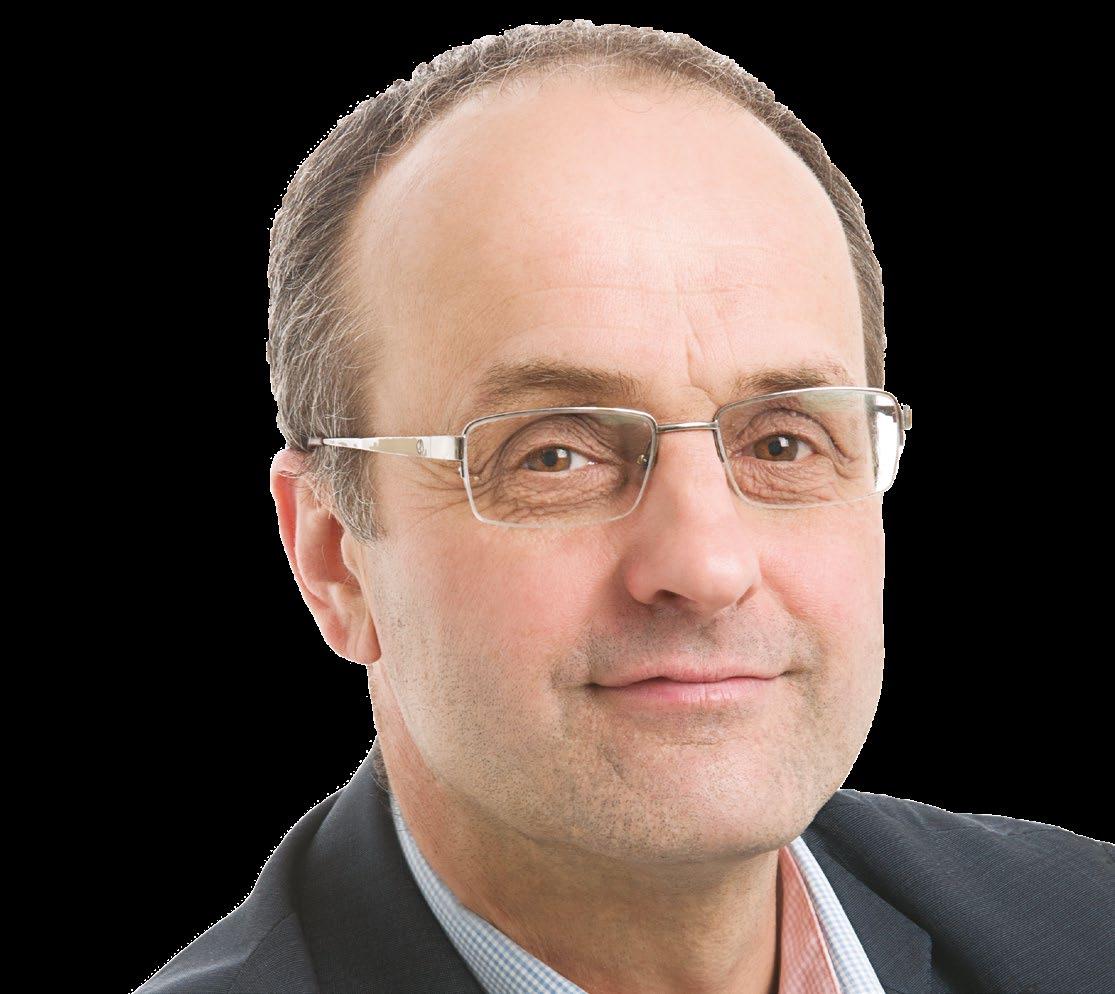
AC: The leadership spark can come from anywhere, at any time. For you, it seems to have come quite early on in your career. For me, it didn’t come until much later. My point is, this spark doesn’t necessarily have to be within a formal working environment. We don’t need more leaders with ‘director’ after their name – we just need more leaders who can make a real difference. You are in the foothills of leadership and I believe you will go on to be a leader in whatever field you choose. But your story needs to replicated thousands of times. So I think one of the missions of the IoL is to break down the barriers and show that leadership is for anyone – whether it’s in the voluntary, commercial or public sector, and that we should not too narrowly define who is a leader.
AA: Young people need role models to whom they can relate. Also, trusting young people with responsibility makes such a difference – we do it with our work experience students. When you pass on the power to individuals, they’ll take charge and often genuinely surprise you, but you need to create that space for them to grow.
Aziza Anjum is organisational development practitioner apprentice at Hounslow Council. She is also events coordinator for Outer Circle, a network for apprentices. Andrew Currie is head of organisational development and learning at Hounslow. He has more than 20 years of experience in leadership, learning and development in both the private and public sector.
* gallup.com/394373/indicator-employee-engagement.aspx
We’re looking for people to take part in ‘In conversation’. Please email louise.parfitt@ cplone.co.uk to express your interest

In the era of artificial intelligence, authentic leaders are needed now more than ever and must embody their brand’s values to protect its reputation, says Nick Gold
Over the past couple of years, businesses have entered a whole new world in which artificial intelligence (AI) can automate more of our manual everyday tasks. That might sound intimidating, but it’s inescapable. So, as AI strips back our practical responsibilities, it’s your reputation that upholds your business and helps you stand out from the crowd.
As leaders, we are hyper aware of our reputation. In 2024, Speakers Corner commissioned a survey in which we found that for almost two-thirds of business owners, reputation management is a greater concern than falling profits, potential recession and staff turnover.
When everything else is out of your hands, your personality is the one thing you can control. That’s why the most successful leaders are those who don’t just manage their reputation: they live and breathe it.
Managing reputation under the microscope
In our perpetually online world, everything is magnified. We have 24-hour news cycles and viral posts that can send a single opinion into the stratosphere. Everyone
everywhere has a platform on which to share their thoughts (or air their grievances) – so, if you’re leaving it up to everyone else to talk about your business, you have much less control over your reputation than you used to.
It’s unlikely – maybe even impossible – to manage your reputation and get everything right 100% of the time. But if you embody your values, you can at least own your failures with vulnerability and openness. This builds connections with people, encouraging them to believe in you and your brand.
Offline vs online reputation
Online reviews are everywhere. Sites such as Tripadvisor and Trustpilot are designed to establish your trustworthiness as a brand via customer reviews. Even chatbots such as ChatGPT and Perplexity can offer up recommendations.
But with companies incentivising users to leave feedback (and reports of fake reviews), many users treat online opinions with a degree of cynicism. We don’t just want to hear from the small percentage of people who love or hate a brand. We’re interested in experiences from everyone in the middle. This comes from anecdotes and human interaction, not just online reviews.
Customer experience is still king
Customer experience lays the foundation for your reputation. Customers are influenced by so many factors that you need to keep in mind – from external review sites, influencer recommendations and information from people they know, to their own first impressions.
It is possible to attend to all these factors while maintaining your personality and reputation. Take Disneyland. Disney has resorts in California, Tokyo, Paris, and more. Each park has the same Disney ‘magic’, but attends to local sensibilities depending on its location. The experience isn’t the same for everyone, but visitors buy into it because of the Disney brand.
That’s why it’s more important than ever to establish and uphold your customer experience standards. When customers know and trust you, they are more likely to forgive the odd blip and support you through turbulent times.
Repairing vs learning from reputational slip-ups
Few businesses escape controversy completely, even if you do everything right. One person’s bad experience can go viral, creating a storm of negative publicity. According to our survey, a third of businesses have experienced negative media attention, reduced profits, and even withdrawn investment as a result of reputation issues. Where a few errors would have gone unnoticed a decade or so ago, businesses now know that a single slip-up could send their reputation spiralling
“When everything else is out of your hands, your personality is the one thing you can control”
out of control. This creates a lot of pressure for business owners: any action you might take can be magnified to the nth degree and brought to the fore. As a result, we spend a lot of time thinking about our presentation, reputation and the potential for fallout.
But the truth is, if we own our mistakes in the same way as our successes there’s no real need for large-scale damage control. By approaching everything we do with vulnerability and a willingness to learn, our customers will see us for who we are, knowing we live and breathe our values.
The concept of reputation management is flawed because it requires a reactive approach to bad publicity. Instead, leaders must understand their brand, embody its values, and share them with the world.
By doing this, you can shape the conversation around you and your business, rather than waiting around for the influence of others. It puts you in the driving seat and helps build deeper connections with your most important stakeholders – and, if controversies crop up, you’ll know how to deal with them, using the same empathy and honesty that form the foundations of your reputation.
In an era when AI is transforming how businesses work, reputation has become more than just a protective shield – it’s become the most powerful business asset you can have. Automation might be able to take over systems and processes, but it can never replicate authenticity, trust and human connections. These are qualities that we, as leaders, need to demonstrate through our consistent actions, clarity of our values and meaningful engagement.
In this emerging landscape, it seems that the leaders who thrive are often those who consciously shape their own narrative; leaders who reflect their brand in every decision and interaction. Increasingly, reputation appears to be less about perception management and more about how we consistently show up, particularly when things go wrong. It’s becoming clear that reputation isn’t a stand-alone strategy, but rather a fundamental element of how a business operates and is experienced every day.
In a world that’s more connected, more automated and more judgemental than ever before, reputation can no longer be about damage control. It needs to be about identity. Your leadership needs to speak louder than any algorithm ever could.
Nick Gold is the owner and managing director of Speakers Corner, a market-leading speaker bureau and consultancy with a portfolio of more than 6,500 speakers. He is also a director of Speaking Office, a bespoke management company for speakers and artists, and the founder of Future Voices.
Paulo Cardoso do Amaral considers the leadership skills required to harness artificial intelligence
Artificial Intelligence (AI) is a powerful, yet paradoxical, tool for leaders. Its potential is immense, as large language models can quickly analyse vast amounts of unstructured data and provide insights or answers at unprecedented speeds. While empowering, this capability conceals significant risks.
AI can produce confident and polished answers without revealing the reasoning behind them, creating a potentially dangerous illusion of accuracy. In essence, it acts as a force multiplier for decisionmaking, but its inner workings remain opaque. To fully harness AI’s potential, today’s leaders must develop specific skills and mindsets that leverage AI’s strengths while mitigating its risks.
AI’s double-edged sword: power and opacity
AI’s lack of transparency can mislead, so the first essential skill is discernment – the ability to question AI outputs, examine underlying assumptions and demand clarity. The more we depend on AI to make decisions for us, the more rigorously we must verify its outputs and maintain situational awareness.
Trust, delegation and responsibility
“The more we depend on AI to make decisions for us, the more rigorously we must verify its outputs and maintain situational awareness”
Just as great generals delegate tasks without abdicating responsibility, modern executives must assign analytical or creative tasks to AI while maintaining oversight and validation. Sun Tzu’s ancient focus on preparation and intelligence gathering underscores the importance of calibrating trust in AI wisely.* Leaders can set the right tone by ensuring that rigorous quality checks and a culture of continuous human oversight accompany the delegation of cognitive tasks to AI.
AI systems are only as effective as the information they receive and the context in which they function. Curating knowledge helps minimise the risk of
poor-quality input/output (garbage in, garbage out) and prevents the neglect of important insights buried within misinformation.
Sun Tzu’s timeless wisdom
Amid rapid technological change, the most profound leadership challenges remain deeply human. Sun Tzu outlined virtues for victorious generals that are remarkably relevant for today’s executives navigating AI adoption.
The first piece of counsel is wisdom, which, in this context, refers to keen perception and unbiased judgement. Effective leadership decisions depend on good intelligence and clear assessment, so modern leaders must train themselves (and their AI systems) to filter out noise and see reality as it is. This involves the ability to recognise weak signals, which requires vigilance against cognitive bias. Such strategic clarity helps prevent both blind optimism and needless panic amid AI’s hype cycles.
Sun Tzu’s next virtue is humility, which translates into a mindset of ‘we know that we don’t know’. This allows leaders to learn from anyone, including frontline employees, competitors, and even AI tools. Encouraging experimentation and accepting failure without shame becomes an inevitable part of learning. Instead of hiding mistakes, effective leaders treat them as feedback. Learning from setbacks fosters resilience and innovation, transforming short-term missteps into long-term knowledge gains. It also builds trust within teams, as people recognise that leaders value truth and growth over saving face.
Perhaps most importantly, Sun Tzu emphasises learning and adapting as core leadership virtues. In an environment where AI technology is continually evolving, the meta-skill for leaders is the ability to ‘learn how to learn’. Today’s leaders must be ready to change organisational practices as new AI tools emerge, or as old assumptions are proven wrong.
Sun Tzu also described classic leadership qualities for inspiring and directing teams. Rigour (discipline and consistency), benevolence (genuine care for followers), courage and commitment (to instil confidence and loyalty), sincerity (integrity in words and actions), impartiality (fairness), serenity (self-control under pressure) and impenetrability (the ability to keep plans confidential) all gain new significance in the context of AI.
For instance, rigour and impartiality are directly relevant when establishing data governance and AI ethics, ensuring that decisions are consistent and fair. Sincerity and benevolence are evident in how a leader communicates AI-driven changes, while self-control is vital when confronting inevitable AIrelated crises or hype, as the leader’s steadiness will set an example for the entire organisation.
Sun Tzu also warned of five faults that can






















































































































































result in a leader’s defeat: recklessness, cowardice, a hot temper, sensitivity to flattery or insult, and excessive softness. His ancient checklist of do’s and don’ts serves as a timeless guide for modern leaders’ emotional discipline in making the most of AI.
Machiavelli’s virtù: character in the AI age Niccolò Machiavelli offers insights into the character and strategic acumen required to achieve long-term success.**
In a business context, his concept of virtù (from The Prince) represents a leader’s skill, courage, decisiveness and strategic perception. It underscores the inner strengths a leader must cultivate to harness AI: mastery of tools, boldness to act, resolve to choose and insight to shape strategy with a human touch. With these qualities, a leader can guide their organisation to not only achieve short-term wins with AI, but also to secure sustainable advantage and loyalty in the long run.
Towards human-centric AI leadership
Leading in the age of AI is a strategic balancing act. On one side are technical tools and data. On the other are timeless human principles of leadership: judgement, ethics, emotional intelligence and courage. To unlock AI’s full potential, leaders must navigate both realms, aligning high-tech capabilities with human-centric wisdom.
The ancient masters of strategy remind us that iStock


































“Modern leaders must train themselves (and their AI systems) to filter out noise and see reality as it is”
success arises from preparation, clarity, adaptability and character. When technology pairs with strong leadership values, AI can become an extension of our minds, amplifying innovation and insight.
In practical terms, this means investing in people’s capabilities to understand and question AI, cultivating a culture that values knowledge and truth over quick answers, and leading by example in demonstrating technical savvy and wisdom. By combining Sun Tzu’s preparedness and Machiavelli’s virtù with modern tech know-how, executives can unlock effective leadership in the AI era.
Paulo Cardoso do Amaral is author of Business Warfare, a globally recognised strategist and an expert in competitive intelligence. His work bridges the gap between corporate risk, geopolitical strategy and cyber resilience.
* Sun Tzu, Chinese military strategist and general, who is considered the author of The Art of War, a guide to strategy and tactics for rulers and commanders.
** Niccolò Machiavelli, Italian Renaissance political philosopher and statesman, and author of The Prince (Il Principe).

Adrian Goddard, commercial director at the Chartered Institute of Payroll Professionals, talks to Martin Bewick about a business function that’s often overlooked – until it’s suddenly crucial
Adrian Goddard works in a sector where the majority of the feedback employees receive is negative. “You only hear from people when things go wrong,” he says, “There’s never, ever, any recognition that, hey, you did it well.”
Such is the reality of working in payroll. The reason for such a polarised experience of customer feedback is simple: payroll is about people’s livelihoods – their ability to pay monthly bills and put food on the table for their families.
“In payroll, you’re dealing with something that’s highly sensitive,” says Goddard. “It’s somebody’s money and you must have a great level of scrutiny

to ensure that it’s right. If it’s not, there’s obviously going to be a backlash. That’s the challenge. If staff are being paid on time and accurately, every time, there’s no issue. People are happy to allow the payroll function to continue as it is. But if anyone’s pay doesn’t go through on pay day, or if pay is incorrect for a number of staff members, that’s when you hear the noise – and that’s when I guess the spotlight is on your payroll function and how it needs fixing. Payroll is a fundamental hygiene factor for every business.”
A foundation in sales
Goddard started working in payroll in 2012, selling software and payroll services to accountants, payroll
“People might be angry, in tears or confused. Would you really expect a computer to engage with that and respond?”

bureaus and small and medium-size businesses. He very soon learned that, from a commercial perspective, payroll is all about credibility.
“If you’re not credible when you’re trying to offer software and services, people won’t buy into you. Your job is to give them the confidence to make the investment. One of the earlier lightbulb moments I had was that it helped to sit down with them, share a screen with the software and show them, step by step, what they needed to do to improve their payroll. It meant I was able to understand and practise payroll in a more handson way, which then helped when engaging with prospects and customers.”
Goddard is now commercial director at the Chartered Institute of Payroll Professionals (CIPP).
“I’ve been at director level for the past four years and, at the CIPP, I’m responsible for all things marketing, events and sales within the institute. Part of my role is also to help steer the CIPP so we continue to have
a strong influence within the payroll industry, and to make more people aware of its importance.”
The hands-on, human-first approach that Goddard brought to sales is useful when navigating the technological changes that are, as with other sectors, impacting payroll.
“AI is having an impact,” he says. “People worry that technology will take their jobs, but it’s only likely to do that if you don’t stay up to speed. It’s all about being able to process payroll accurately.
“Some payrolls are relatively static and the same every month. AI could probably do a lot of that. You could use it to complete the process, and then a human would come in to do the checks and make sure everything’s correct before you sign it off. But most payrolls aren’t that simple. You may have complexities surrounding staff members’ contracts, and this may have implications for their
pay. Then there are various calculations if somebody has worked a weekend or completed overtime, or had an overnight stay for business that’s incurred expenses. Or maybe someone works across different locations. There are so many things that go into it. AI can support the process, but probably more for the mundane, repetitive tasks.”
In an area that has the potential to trigger strong emotions, Goddard believes human connection will remain vital. “I don’t think you’ll ever be able to take the person away from the role. You need supportive staff members if pay does go wrong. People might be angry, or in tears, or confused. Would you really expect a computer to engage with that and respond? You need empathy – somebody to be compassionate about other employees and to find a solution that supports personal circumstances.
“For many, the concept of payroll is simply pushing a button, but it’s far more than that. It does a whole raft of things and the future of payroll depends on them all working together. It’s not just the payroll professionals themselves, it’s the whole community: business leadership; specialists in consultancy and implementation of payroll projects; the people that build the payroll platforms; sales and marketing teams.”
While automated payrolls are becoming the norm, Goddard says there is still a cautious approach to technology: “Perhaps because of the level of scrutiny that goes into payroll, there’s a lot of nervousness. At the CIPP, we support education to reduce that nervousness and enable the payroll community to embrace tech. The focus is on how you can position yourself so that you’re part of the strategic development of the organisation, in terms of what payroll looks like in future, rather than getting left behind.
“Your organisation doesn’t want to come into disrepute for non-compliance and suffer reputational damage – and, of course, you need to protect your workforce. HMRC changes legislation regularly. You have to stay on the ball with what’s required of you.
“One of the main challenges right now is that we’re at a transitional moment. We need to be in a position of strength and really understand how demands within payroll will change over the years –and how we can use our skills and knowledge within our organisations to add value and be a pivotal stakeholder within the business.”
For Goddard, good leadership is essential through times of business transition.
“There are three things I focus on that have really become my leadership brand: the ‘three Cs’ – communication, culture and coaching. Most problems occur because of poor communication and facilitating a poor culture, and because people aren’t being coached and developed well. If you lead without
“Even in the most difficult of times, relationships built on good communication make for a healthier workforce that finds the right way to get through those periods”
coaching, you won’t draw excellence and a higher levels of performance from your team or employees. Then, if you don’t create the space to grow a positive culture in which everyone feels engaged and motivated to be their best, and to operate at the highest level possible, you won’t foster a winning mindset. That culture also needs to be collaborative, with people cross-pollinating ideas and skills.
“With communication, it’s about having an open-door policy and genuinely wanting to get to know and connect with people. If you can build a relationship where you communicate effectively, it’s like a bridge of truth. Even in the most difficult of times, relationships built on good communication make for a healthier workforce that finds the right way to get through those periods.”
At the heart of this is the view that leadership is about enabling people to become their best.
“It’s easy to fall into the temptation to tell people what to do all the time. Yes, people need guidance sometimes, but sometimes you need to allow them to figure it out for themselves. Most of all, though, they need to see that they’re empowered to make certain decisions, and to learn and grow, and to reflect on any mistakes or challenging situations that arise. It’s about becoming more trusting.”
There’s something of a virtuous circle here, in which hands-on learning leads to better understanding, which leads to potential improvements in culture, coaching and communication. This, in turn, improves trust, which then positively impacts performance by enabling people to learn for themselves.
This is especially vital in a sector such as payroll, says Goddard, where misunderstandings and ignorance of the job can have serious consequences.
“Every month, payroll teams must meet strict deadlines. There can’t be any slip with those deadlines, because that means the workforce doesn’t get paid. People in the team are under great pressure. We really need to understand how it works and what it means to be in that team.
“We would expect an employee to be angry if an error is made and they don’t get the pay they were expecting, but the individuals in the payroll team can’t rise to that. They must stay calm, irrespective of the workload and the demands of the position. They have to be the rock for the business, and that should be recognised.”
Payroll is a big issue for business
87%
30.4m
Running payroll is not easy
Number of payrolled employees in the UK of businesses use BACS to pay employees of professionals still need up to a week to complete a pay run of businesses across the UK and Ireland admit to making payroll errors every month of UK PAYE employees say they have received incorrect paycheques from their employers
Around of SMEs outsource their payroll 2/3
76% 91% 25%
The First Time Approval (FTA) rate is the percentage of payroll runs that are approved at the first attempt and don’t require any changes
The highest FTA is in China
96.54%
43.49%
The lowest FTA is in the UK of payroll mistakes in the UK arise from human error is the potential cost of payroll mistakes to each UK business (of 500 employees or more)
15%
£150,000 of UK companies still use manual processes for their payroll systems 72% of UK employers have started to use AI-powered agents or chatbots to support employee payroll queries
42%
1/3 of payroll professionals have no back up for BACS of payroll providers now want every single payroll task automated 24%
Sources: CIPP, Office for National Statistics, PwC, Global Payroll Association, MHR, SD Worx
One in every 48 working-age adults in the UK is living with cancer – and, says Tara Ferguson, there is a lot more leaders can be doing to support them in the workplace
Having worked in HR leadership roles for more than 20 years, I was fairly confident I knew how to support an employee impacted by a cancer diagnosis with empathy, compassion and fairness. My own diagnosis of breast cancer in August 2023 changed all that. I realised that, while well intended, I’d got a lot of things wrong – from assumptions, to language, to how I understood the disease and its treatments, and what true support really looks like.
For years, cancer – the whispered ‘c word’ –has been treated in workplaces as either an acute illness or a terminal one. In the first scenario, the person goes off for treatment, perhaps surgery or chemotherapy, then hopefully returns once they’re ‘better’. In the second, care and support are shown, and policies such as early ill health retirement or death-in-service benefits are applied.
Advances in science and healthcare have transformed this narrative. According to Cancer Research UK, survival rates have doubled in the past 40 years and many people are now living with cancer as a long-term, chronic condition. Even those with advanced (Stage IV) diagnoses can live full and active lives for many years. These medical breakthroughs are brilliant for longevity and quality of life, but they also require a rethink of how we support and lead employees at work.
The day after my diagnosis, I spoke to my manager, Chris, on a virtual call. He knew I’d been awaiting biopsy results and was sad to hear my news. His immediate response – and one that became a consistent theme throughout the following nine months – was: “What can I do to help?”
At the time, I was a strategic people business
partner to two executive team members and their functions at a medium-sized biotech company. Chris immediately suggested we reassign one of those functions to a colleague – effectively halving my workload overnight. It was such a relief. I was facing a mountain of what I call ‘cadmin’ – cancer admin – the endless calls, appointments, scans, tests and difficult conversations that pile up in those early weeks.
I also chose to be open with colleagues and connections. I posted the news on LinkedIn and the response was overwhelmingly supportive.
As my treatment plan became clear – surgery, followed by eight rounds of chemotherapy, then more surgery and long-term hormonal therapy –Chris and I spoke again. I wanted to keep working in some way. My work is part of my identity and my colleagues are part of my community. So we agreed I’d take on meaningful projects without urgent deadlines – work I could pick up when I felt well and put down when I didn’t.
The benefit was huge. I didn’t feel reduced to a diagnosis. I felt like me. I had purpose. And I stayed connected. And yet, my experience is still the exception.
According to Macmillan, around 890,000 people of working age are living with cancer in the UK – that’s one in every 48 working-age adults. To put that in perspective, around 840,000 people
claim statutory maternity or paternity pay each year – roughly one in every 51. As employers, we’ve built structured systems to support new parents with policies, flexibility and cultural norms that make it easier to manage work and change. Shouldn’t we do the same for the growing number of people working through and beyond cancer?
When my active treatment ended, I was keen to return to my full-time role. Chris, again wisely, asked me to draft a phased return and then gently suggested my plan might be a little ambitious. He was right.
My long-term treatment had only just begun. Because my cancer was hormone-receptor positive, my oncologist prescribed endocrine therapy to remove all traces of oestrogen from my body. That meant daily medication for 5-10 years, monthly injections for the first year (and quarterly ones after that), bone-strengthening infusions and, more recently, a new drug that requires monthly blood tests and comes with new side effects.
At 42, I entered immediate medical menopause, bringing with it hot flushes, memory issues, joint pain, fatigue and poor sleep. Alongside this, I began experiencing the emotional weight of cancer: fear of recurrence, identity loss, and regaining my usually fiercely guarded independence. iStock
Finding opportunity from challenge
Last summer, a company restructure led to my role being made redundant and, to me, this was a good thing. I’d always planned to launch my own business and this gave me the financial breathing room to go for it.
I founded Onward With You in December 2024. Drawing on my personal and professional experiences, I now work with leaders and organisations to improve how we support people affected by cancer. I offer coaching, leadershipteam development, and awareness training around cancer and work. I’ve been overwhelmed by the engagement with my LinkedIn posts – clearly, this is something people are ready to talk about.
And talk we must. The statistics are stark, but the solutions are simple. You don’t need to be a therapist or a doctor to support someone with cancer. You just need to lead with humanity. Listen, ask, offer flexibility, and stick with them for the long haul.
That’s what great leadership looks like when cancer comes to work.
Tara Ferguson is the founder of Onward With You, which was set up to do three things: develop leadership teams, provide business coaching and transform how workplaces support people affected by cancer.
Leadership tip 1: When someone tells you they have cancer, don’t worry about having the perfect response. Just make it clear you’re there for them and want to help however you can. That presence and willingness go a long way.
Leadership tip 2: If an employee wants to work during treatment, but has unpredictable capacity, think of all those ‘important but not urgent’ tasks sitting on your team’s to-do list. Those are perfect –they matter, they add value, and they allow the employee to contribute without pressure.
Leadership tip 3: There is no clear ‘back to normal’ after cancer. Be curious and open, ask about ongoing treatments, future scans, emotional wellbeing, and what the next few years might involve. Even just asking shows care, understanding and leadership.
Coaching for neurodivergent executives: it’s the strategic advantage you’re missing, say Alex Campbell and Katie Friedman
In today’s leadership landscape, innovation, agility and emotional intelligence are prized qualities. So it’s surprising that one of the most effective tools for cultivating these strengths in neurodivergent leaders is still widely overlooked: ADHD coaching.
We’ve coached hundreds of adults with ADHD – many of them senior executives, entrepreneurs and founders. Some came after burnout. Others were performing well on the surface, but struggling silently behind the scenes. The throughline? They’d spent years trying to work like everyone else, wondering why they couldn’t keep up. Coaching gave them the space to stop trying to be someone they’re not and start working with their brains, not against them.
. The hidden costs of masking
Many neurodivergent leaders spend years excelling professionally while feeling like a mess privately. They mask their difficulties, build workaround systems, and work twice as hard to achieve the same outcomes as their peers –often without realising that ADHD is part of the picture. From the outside, they look driven and high-performing. Inside, they’re often exhausted, disorganised and fighting a constant sense of underachievement.
One executive client described it perfectly: “I can run a multimillion-pound company, but I still can’t manage my inbox or get out of the house in the morning without chaos.”
This kind of unevenness is common with ADHD. Our brains don’t follow neat lines. You might be brilliant at big-picture vision, but chronically late to meetings. Great with
“ADHD coaching helps neurodivergent executives see that their brain wiring is not the problem – the problem is the environment into which they’ve been trying to fit”
people, but unable to start the most basic admin task. What coaching offers is not a quick fix, but a new lens. One that helps you recognise your strengths, name your challenges without shame, and develop sustainable systems that work with how you operate, not how you think you should.
Consistency is overrated
There’s a harmful narrative in leadership culture that consistency is the ultimate key to success. While structure and habits are helpful, this mindset can be deeply ableist. It privileges neurotypical patterns of motivation, especially brains wired for importance.
ADHD brains are wired for interest, not importance. This makes consistent productivity not just difficult, but, at times, neurologically impossible. Our normal is to be consistently inconsistent, and when we try to override that by forcing ourselves to be more consistent, we end up burnt out or disengaged.
Take Alex’s personal example with exercise. He loves a spin class – ’90s house music, strobe lights, the lot, but only for about two weeks. Then it’s over. What works instead? Leaning into the inconsistency. Having a rotation of options, such as running with a friend, circuit training or a sea swim, so there’s always a way to stay engaged. The fascinating part is, the interest often cycles back (pun intended). In a few weeks, the bike calls again.
The same applies at work. Novelty, variety, connection and autonomy are the fuel. Smart neurodivergent leaders learn to harness that instead of fight it. Coaching supports this shift by helping you build flexible structures, anticipate energy cycles and create meaningful accountability that respects how your brain operates.
Traditional coaching approaches often rely on linear goals, rigid accountability and standardised structures. For ADHD clients, this can feel restrictive. While structure is vital, too much of it kills interest. Coaching that works for neurodivergent executives needs to be both anchored and adaptable.
One way this shows up in our work is the time we spend at the start and end of sessions. Asking an ADHDer “what do you want to focus on today?” might launch a spiral of divergent thinking. It takes time to drill down to the true priority, and doing that successfully helps generate the clarity and interest needed to take action. Similarly, we don’t skip over the “what now?” bit towards the end of a session. For many clients, it’s the hardest part and the most boring. If you don’t make the actions interesting or connected to what matters, they won’t happen.
“When you understand how your brain works, you stop wasting energy on hiding, fixing or forcing yourself into boxes thatwere never built for you. You start leading from a place of strength”
Effective ADHD coaching means supporting executive function (the brain’s management system) in real time. It means designing actions that feel achievable, engaging and relevant. It’s about setting a direction, not a fixed goal, and giving space for creativity and insight to emerge. This isn’t a productivity hack; it’s a leadership tool.
ADHD coaching helps neurodivergent executives see that their brain wiring is not the problem – the problem is the environment into which they’ve been trying to fit.
One client, a senior manager, came to coaching with shame about his emotional reactivity in meetings. He’d been told his whole life to tone it down. But as we explored further, it became clear that he had an extraordinary level of emotional intuition. He was scanning the room, sensing dynamics, and adapting his communication accordingly, without even realising it. That insight changed everything. He no longer saw his emotions as disruptive. He saw them as data and, from there, he led differently.
These kinds of insights don’t come from tips or tools. They come from slowing down, getting curious, and asking better questions. That’s what ADHD coaching offers: a space for reflection, realignment and sustainable self-leadership.
A new kind of success
Many late-diagnosed ADHDers have spent their lives in survival mode – masking, pushing through, internalising blame. Coaching interrupts that pattern. It helps leaders step into their roles with more energy, clarity and purpose.
Because when you understand how your brain works, you stop wasting energy on hiding, fixing or forcing yourself into boxes that were never built for you. You start leading from a place of strength – and that isn’t just good for you; it’s good for your team, your business and the future of leadership.
Alex Campbell and Katie Friedman are co-founders of Gold Mind Academy and authors of ADHD… Now What?, a new book about understanding your ADHD wiring and reclaiming your power.
The hidden cost of checking emails on holiday – according to a neuroscientist. By Amy Brann
You promised yourself you’d switch off this summer. But there you were – by the pool, in a queue for ice cream, or sneaking five minutes before dinner –scrolling through emails ‘just in case’. It seems harmless. In fact, it feels responsible. But from a neuroscience perspective, checking emails on holiday can significantly undermine the restorative power of time off and diminish the very cognitive performance you’re trying to protect.
What happens in your brain when you ‘just check’
The moment you open your inbox, your brain’s salience network activates – scanning for urgency, threat or problems to solve. Even a brief scan triggers the stress response: increased cortisol, faster heart rate, heightened alertness.
It doesn’t matter if you reply or not. The mere act of re-engaging with work-related tasks pulls your brain out of the recovery state it needs to restore attention, creativity and emotional regulation.
This mental shift activates the prefrontal cortex – the area responsible for decision-making and focus – and interrupts the work of your default mode network (DMN), which is only active when we’re resting, daydreaming or reflecting. It’s the DMN that helps consolidate memory, integrate learning and generate the kind of long-range thinking on which leadership depends.
Even one email can mentally re-anchor you to the workplace, initiating what psychologists call ‘attention residue’ – where part of your brain stays tethered to unresolved tasks or social dynamics (Leroy, 2009).
The real cost: reduced recovery, blunted creativity
In leadership roles, your brain is your biggest asset – and it needs time in a non-reactive, non-taskfocused state to function at its best. That doesn’t just mean sleep. It means space to:
• Reflect without urgency
• Let scattered thoughts coalesce into insight
• Reset emotional baselines and detach from chronic tension.
By checking emails – even briefly – you interrupt the biological and cognitive benefits of rest. You may still be lying in the sun, but your nervous system is back in the office.
“Leaders who fail to detach from work during holidays report lower engagement, poorer sleep, and higher stress when they return”
You don’t need to swing from hyper-engaged to completely off grid to protect your brain. But you do need to design holidays in a way that enables full cognitive detachment, even temporarily. Here are four neuroscience-informed strategies:
1
Set a digital boundary in advance. Pre-commit to no email access for 72 hours minimum – the time it takes for the brain to fully downshift.
2
Designate a single check-in window (if necessary). If email absolutely must be checked, do it once daily at a fixed time, in a fixed space – not impulsively or reactively.
3 Outsource urgency. Appoint someone to escalate only genuine emergencies – this reduces subconscious scanning for ‘what ifs’.
4 Replace the scroll. If you’re tempted to check in, redirect your attention to something restorative: journalling, reading fiction, even aimless walking. These re-engage the DMN and help the brain rewire creatively.
Research has shown that leaders who fail to detach from work during holidays report lower engagement, poorer sleep, and higher stress when they return (Sonnentag & Fritz, 2015). And the cumulative effect of this is real: decision fatigue, lower resilience and depleted cognitive flexibility.
Why it’s so hard to resist
We check ‘just in case’. But, often, the deeper drive is dopamine-based. Email offers unpredictable rewards: sometimes it’s urgent, sometimes praise, sometimes a problem to solve – and your brain gets hooked on the intermittent reinforcement cycle. This pattern wires the brain for vigilance, not rest. Moreover, leaders often carry a sense of personal responsibility and emotional load. But maintaining that cognitive tether while away doesn’t signal commitment – it signals lack of boundaries, which, over time, leads to burnout.
Final thought: rest is a strategic resource
For leaders, rest isn’t indulgence – it’s mental infrastructure maintenance. Without it, we lose the very capabilities leadership demands: long-term thinking, emotional regulation, strategic empathy, and perspective.
If you want to return from your next holiday clear-headed, energised and ready to lead, then close the inbox. Let your brain do what it’s built to do: recover, rewire and reset.
Amy Brann is an applied neuroscience expert, keynote speaker, founder of Synaptic Potential, and acclaimed author of Make Your Brain Work.
Book club REVIEW
WHICH BOOKS SHOULD BE KEEPING LEADERS AND MANAGERS AWAKE AT NIGHT? EDGE REVIEWS SOME OF THE MOST INTRIGUING TITLES AROUND
–99WaystoReChargeYour Career and Life
Authors Beth Benatti Kennedy, Karthik Venkatakrishnan, Songmao (Ben) Zheng Price £13.59, River Grove Books
Resilience: how do we achieve it?
The foundation of this book is the Benatti Resiliency Model, developed by Beth Benatti Kennedy, which encompasses five core strategies: wellbeing, self-awareness, brand, connection and innovation.
Through a passion-driven subjectmatter collaboration, Benatti Kennedy,

Venkatakrishnan and Zheng have created 99 practices within each of the five strategic areas to help boost resilience, professionally and personally.
In many ways, this book is a step-by-step guide. It’s easy to follow and rich with techniques, coupled with real-life stories, colourful imagery and diagrams. It simplifies how to elevate your resilience, one practice at a time.
Some personal favourites: Practice 6: ‘Capture vivid memories via pictures’, with scientific evidence suggesting retrieval of happiness can come from vivid memories – I do love my camera and reflecting on old photos! Practice 56: ‘Understand and focus attention on your circle of control’. This circle is concerned with
Author Rhea Freeman Price £15.29, Bloomsbury Publishing
What’s stopping you from getting to where you want to be?
This question, in the introduction, is an impactful one, and one that grabbed my attention as I navigate my own entrepreneurial journey.
Freeman, a two-time TEDx speaker, NLP coach and PR adviser –among many other roles – has created an empowering book centred on discovering ‘what is stopping you?’.
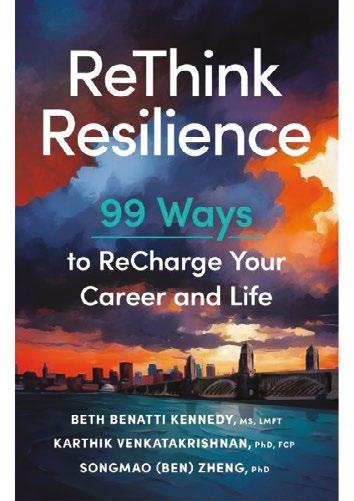
three principles: Circle of control (what is within your direct control); Circle of influence (what you can control indirectly); and No control (where you have no control whatsoever). Our energy and focus should be centred on what’s within our control. A timely reminder. With change being constant, resilience is necessary to navigate our way as safely and effectively as possible. This book, in one word, is brilliant! It will become your go-to resilience roadmap, with directional learning and supportive suggestions throughout. Highly recommended.
With chapters focused on topics such as impostor syndrome, overwhelm, mindset and fear of failure, you will uncover strategies, advice, reallife stories and inspiration throughout.
Freeman breaks down the SMART goal-setting framework and introduces other goal-setting frameworks, such as BHAG – Big, Hairy, Audacious Goal – a method that helps people declare their greatest ambitions. I love it!
There are huge nuggets of wisdom, and lots of self-reflective questions and empowering guidance, which will elevate your confidence, your selfbelief and reaffirm ‘you’ve got this’.
If you have a business or entrepreneurial idea and don’t know where to begin, this book is a mustread. A brilliant, business-centred, empowerment-orientated read.
Author Nick Robinson Price £16.99, Pearson
Why do things go wrong in work?
We can all recall encountering difficult people in the workplace, and knowing how to lead effectively for everyone is a much-needed skill.
Robinson, a former chartered accountant and now executive coach, with decades of experience
–Theboldartofbeingmore irrational and less mediocre
Author Zana Goic Petricevic Price £17.99, Rethink Press
How can leadership be ‘irrational’?
In a vulnerable and honest introduction, Petricevic, a leadership transformation expert and coach, shares the personal story that inspired this book – the brave journey that led to embracing a bold leadership style, which invites leaders to become comfortable with the uncomfortable and to take transformational risks to create a better world for us all.
The book is in three sections: World on the edge – a look at how we lead from a global, organisational and a personal perspective; Leadership on the edge – an exploration of leadership, beginning with ‘being’ and how to develop a bold mindset; and Daring on
in coaching leaders and managers across multiple industries, draws on this vast expertise, and has created an impressive and valuable leadership resource.
It’s structured in two parts. Part one lays the foundation for managing a difficult person – how to identify the signs, the introduction of Robinson’s Matrix of Difficult People, dynamic operating principles, and a visual flowchart.
Part two is more strategic, defining the nine types – Scary Specialist, Dark Strategist, Martyr, Driving Force, Revolutionary, Empire Builder, Worrier, Rock and People Pleaser – and outlining techniques to help manage each type,

whether you are their leader, team member or colleague.
The book is written in a user-friendly manner, with emojistyle illustrations, diagrams, leadership quotes and a useful summary of the nine types, all underpinned by academic referencing. It is overflowing with learning and support.
This book is an essential read for every leader and one that will help to create a better workplace for everyone.
A compelling, abundant, and educational leadership book.
the edge. It concludes with guidance on how to move the ‘being’ into ‘doing’ and create your own bold action plan to realise the difference you seek. As Petricevic states, it is a “call to action for those ready to reject mediocrity and act in service of something greater”.
Mirror moments at the end of every chapter offer reflective questions. One term I really felt drawn to was the ‘passionpreneurial’ mindset, with research highlighted by Petricevic showing that 77% of the global workforce is non-engaged or actively disengaged. Are you sacrificing your passions for the security and

comfort of your current role? A powerful question.
I also found the SOUL Framework interesting – Self (learn), Other (trust), Universe (risk) and Legacy (change) – which can feed into Petricevic’s Leadership Circle Profile assessment tool.
This book, as the title suggests, is bold. It embraces irrationality and is insightful beyond measure. It is one you will revisit, as your leadership journey evolves.

Belinda O’Neill is a business, leadership and wellness consultant, and founder of Be Inspired To Be. She is an award-winning author, speaker, event facilitator, podcaster and educator. She is also a business and community ambassador, having held many voluntary roles, and is currently a judge for the National StartUp Awards. She lives in Co Down, Northern Ireland, with her husband, Peter, and their son, Leo.
Adrian Moorhouse
QHow did you come to be doing the job you are doing today?
I retired from professional swimming when I was 28. I always had an interest in talent pathways and how we look after the younger kids coming through, because my route to it was quite down to chance. The director of swimming at British Swimming [now Aquatics GB] offered me a new role as head of talent development. Together, we created a national programme for talent identification and development, and, of course, leadership and the culture for that is fundamental. I learned about talent identification in a broader sense and I found myself in the wonderful world of HR and business –and I liked it! Then I met a couple of occupational psychologists and we created Lane4 in 1995.
Q If you weren’t doing this job, what would you like to do?
I have chosen what I do now, so I don’t want to be doing anything else. I came out of Lane4 last year, after selling the business to EY, so I had the freedom to choose what to do.
I am still in learning development, but working at a smaller scale with a company called Fieri. I’ve also got
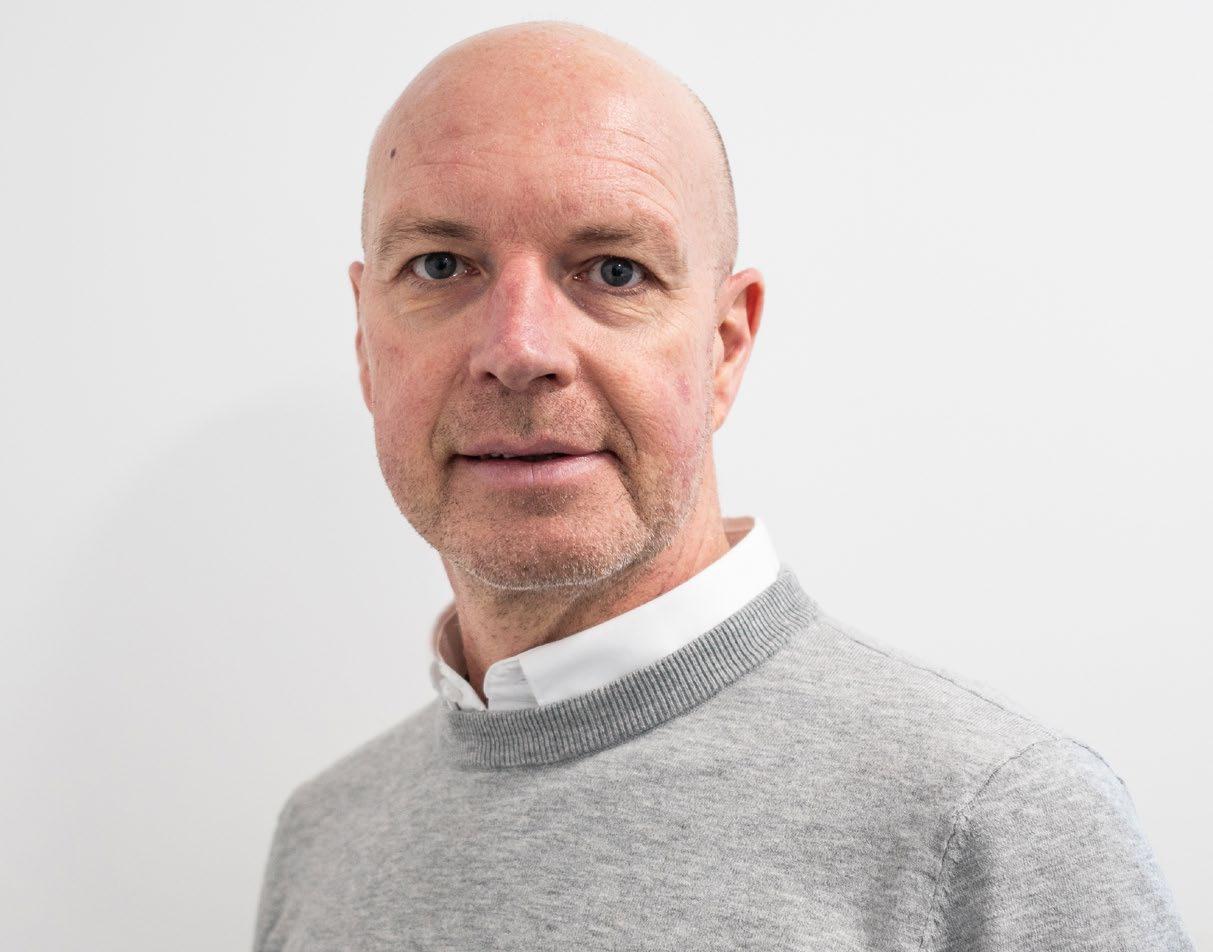
a couple of non-executive roles, as chairman of the Tom Dean Swim School and specialist adviser to the venture capital and private equity firm Ama Capital.
QWhat is one common misconception of your work?
The biggest issue with leadership development is that senior executives often don’t see the connection between developing leaders and organisational performance. As a performer, I wanted to win and achieve things, and I knew that my development was critical to me achieving – they go hand in hand. All too often, executives separate them –there’s culture over there and there’s strategy over here. But you need to develop them together.
QWhat advice would you give to your 18-year-old self?
To chill out more! At 18, I was trying to juggle A-levels and being a member of the British swimming team. I went to the Commonwealth Games in Brisbane the year I took my A levels – I failed them all. I remember the stress at the time, worrying whether I’d messed everything up. So my advice would be – and it’s what I tell my children now – don’t sweat it. You’ll work it out.
QHow do you switch off from work?
I burnt out a couple of times when I overtrained as an athlete, so I am aware that being able to switch off is fundamental to your performance. I learned to meditate very early on. I am a prolific reader, both of fiction and non-fiction; I am very curious about modern history. Music is also important to me; I love going to concerts. I still swim a few times a week, but not competitively – I find it quite calming now.
QWhat is one fact about yourself that most people would be surprised to know?
I resigned from being a member of Mensa at age 22. I think I had joined just to prove to myself that I wasn’t stupid after my A-level failure. Once I’d got the external validation that I was after, I left.
Adrian Moorhouse MBE won a gold medal in swimming at the Seoul Olympic Games in 1988 and was world No 1 in the men’s 100m breaststroke for six consecutive years. He co-founded Lane4 in 1995, which grew to be one of the most highly regarded leadership development consultancies.








